#She mixed up two anime movies about witches
Explore tagged Tumblr posts
Text
So you want to know about Oz! (5)
Now that we looked at the MGM-continuity of movie and cartoons adaptation, I propose you in those post some adaptations that are either more in line with the original novels or... just not following either the novels or the MGM movie, and just doing their own thing. Since there is a lot of Oz adaptations, for this movie I will stay by American productions, post-1939.
First my three faves, and the rest will be under the cut.
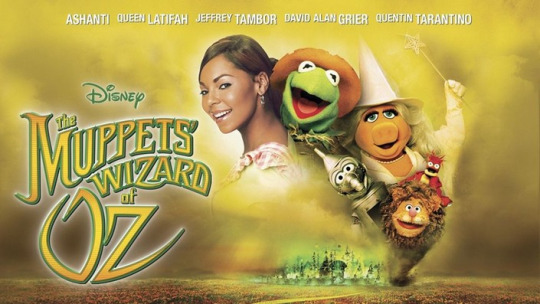
2005's The Muppets' Wizard of Oz
This movie did quite poorly upon its release - and of all the Muppets movies, it is not considered to the best in any way. There is notable use of some old CGI that aged very poorly when it comes to the Wizard's scenes... But, not only does it have one of the most hilarious depiction of the Witches of Oz ever (what do you expect when they are played by Miss Piggy?) and some cool songs - this movie has the honor of being the most book-accurate, book-faithful adaptation of The Wizard of Oz there ever was. (Well outside of Japanese animes I'll talk about later). Yep... this Muppets parody is the closest you can get to experiencing the original novel as a movie. Crazy, right?
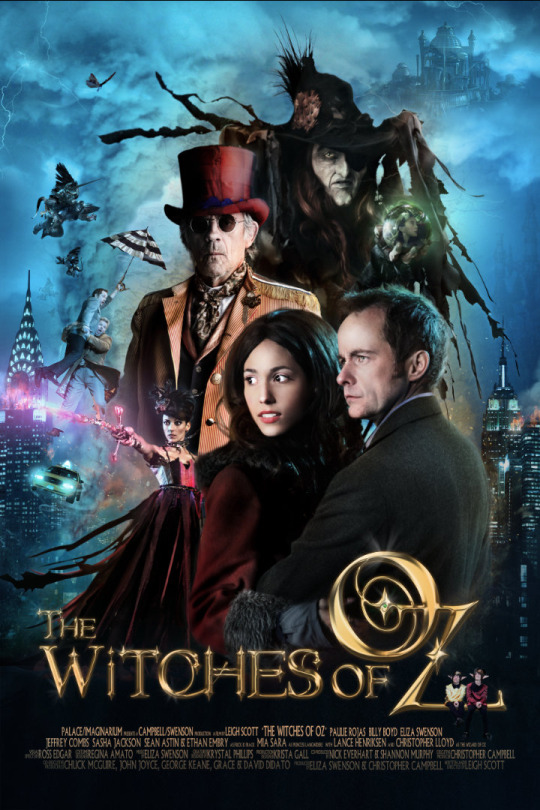
2011's The Witches of Oz
Originally it was released as a mini-series in two parts ; and in 2012 it was recut and edited as a single movie known as "Dorothy and the Witches of Oz" (but the single-movie version deleted a lot of scenes and segments from the complete mini-series). It tells a sort-of sequel to the Oz books (yes ALL of the Oz books), while mixing it with urban fantasy - as young real-life Dorothy, all grown-up in 2000s Oz, is depicted as the current author of Oz books, only for her to discover the fictional adventures in Oz that were written about her are real, and Oz is coming to New-York to get her...
Now... this mini-series aged VERY badly. The special effects are so cheap, most of the characters are insufferable, the plot is very weak... BUT! BUT this mini-series deserves to get some attention and to be known due to specific elements, such as, the most badass depiction of Langwidere ever ; Christopher Lloyd delightfully playing the Wizard of Oz... And the Wicked Witch of the West! This incarnation of the Witch is without a doubt one of my favorit reimaginings of the character, striking the perfect balance between the character of the original novel and the MGM Wicked Witch. Just in design she is the coolest Wicked Witch of the West there ever was. Too bad the rest of the mini-series is... quite cringe.
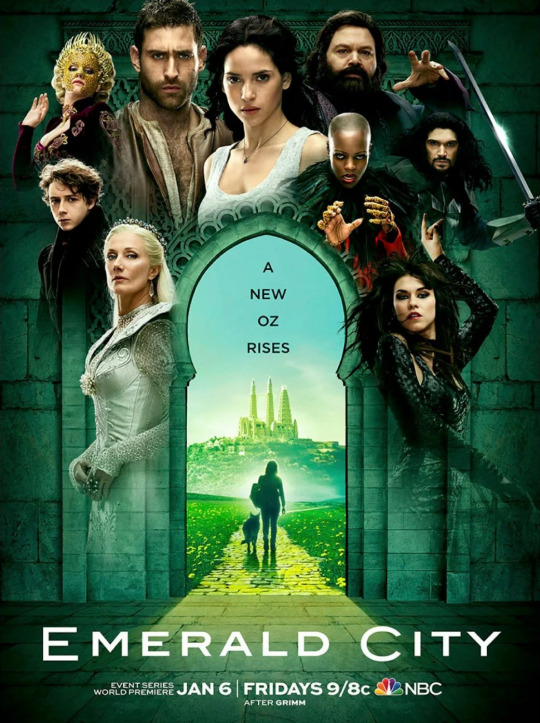
2017's Emerald City
Yet another proof of the "Oz curse" that plagues most of Oz adaptations - because the series got cancelled after its first season, leaving the show unfinished.
What is Emerald City? It was an Oz television series from the era of "post-Game of Thrones". Since the success of GoT, every channel and network tried to create its own dark and gritty big-budgeted high fantasy series... And "Emerald City" is what happened when Oz got caught in the trend.
People were very divided on the show (hence why it ended up cancelled) - some people adored its beginning and got tired of it by the end, others hated the first episodes but by the final ones were eagerly awaiting for the next season. On one side, most people agree that it is too much and that the show handled itself in a strange way, everything being a bit crammed-in. This TV show is actually adapting simultaneously THREE different Oz novels (The Wonderful Wizard of Oz, The Marvelous Land of Oz, Ozma of Oz), all mixed together in a new, dark, adult iteration of Oz, so yes, that's a LOT.
However the show does work out several very cool and interesting concepts, playing around with both the MGM and the novel heritages. And while the story can get a bit convoluted due to the so-many plots and subplots mixing each other in a complicated way and not giving each other enough time to breath, the visuals are 10/10. There was a real visual effort on this show that makes it entirely worth the watch, if just as an eye-candy. They literaly used GAUDI ARCHITECTURE for the Emerald City, come on, how cool is that?
And also it is one of these shows were several actually working languages were created by experts, so that's always cool. I always stand by fictional linguistics.
Now I'll go a bit quicker for these ones because else it's going to be one LONG post:
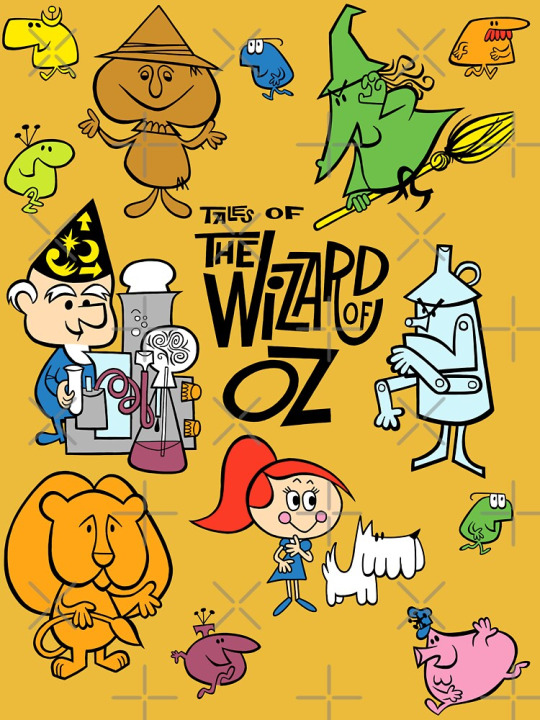
In the 1960s, there was one animated show that dominated the Ozian landscape. 1961's Tales of the Wizard of Oz.
One of the early creations of the future Rankin/Bass studios, it is a cartoon that reuses the settng and characters of "The Wonderful Wizard of Oz"... But not the plot X) Basically Dorothy and Toto end up entering Oz by... by a hole, as if she was Alice. And there she meets her companions and each episode is about them trying to have a wish granted by the Wizard of Oz, or trying to avoid the schemes of the Wicked Witch. So... it is quite a VERY loose adaptation, and the modern cartoon "Dorothy and the Wizard of Oz" is kind of a modern heir to this old cartoon.
After 114 episodes, there was an animated special created to conclude the show. Called "Return to Oz", it IS actually an adaptation of the plot and events of "The Wonderful Wizard of Oz"... But happening after all of the events of the cartoon, and thus taking a different direction in terms of set-up.
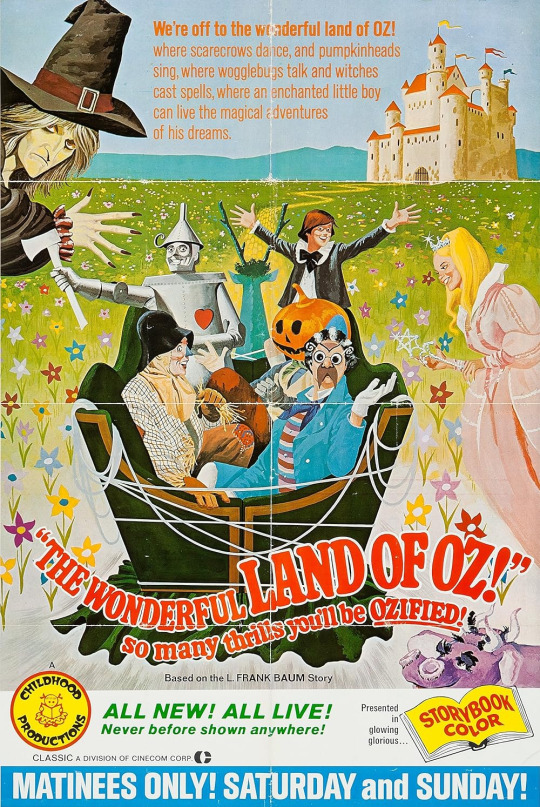
1969's The Wonderful Land of Oz
This low-budget movie was an adaptation of the second Oz book, "The Marvelous Land of Oz". There's quite a lot of interesting stories surrounding this production - from Judy Garland supposedly having been intended as the narrator, to the background actresses having appeared in nude films created by the movie's director... However the movie tend to be ignored or forgotten compared to the other 60s Land of Oz adaptation...
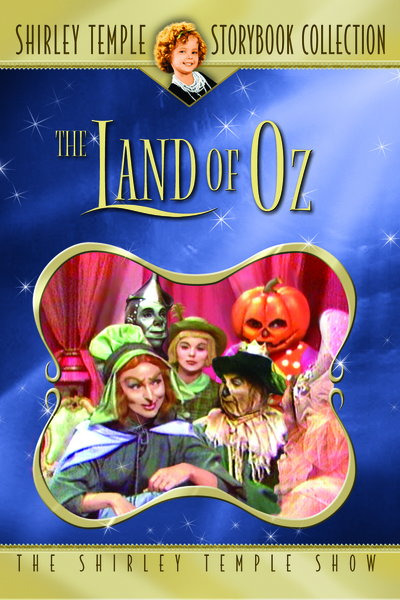
1960's "The Land of Oz". First episode of the second season of Shirley Temple's Storybook
This was a much more famous adaptation of "The Marvelous Land of Oz", if only because of Shriley Temple's name. Retrospectively, I should have added it in my previous Oz post because this mini-movie takes a lot of visual cues from the MGM's Wizard of Oz, such as the Scarecrow and the Tin Woodman being designed after their MGM incarnation, or Glinda's outfit calling for the MGM Glinda's design.
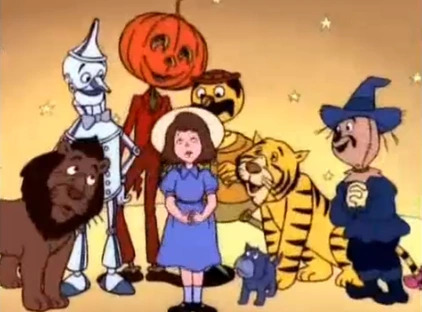
1980's "Thanksgiving in the Land of Oz"
An animated special for Thanksgiving of the year 1980, which is - as the title says - about Dorothy going to celebrate Thanksgiving in Oz. In 1981 it was re-cut to become "Dorothy in the Land of Oz" (with most Thanksgiving references being removed so the animated short could be aired at any time of the year - which is quite a challenge since the special is ALL about Thanksgiving... Dorothy is literaly brought to Oz by a "giant green turkey ballooon", come on!)
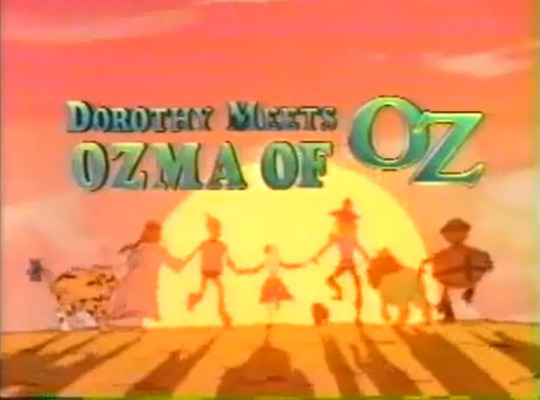
1987's Dorothy meets Ozma of Oz
This animated middle-sized movie is an adaptation of the novel "Ozma of Oz", and remained for quite a long time the only adaptation of Ozma of Oz alongside Disney's Return to Oz.
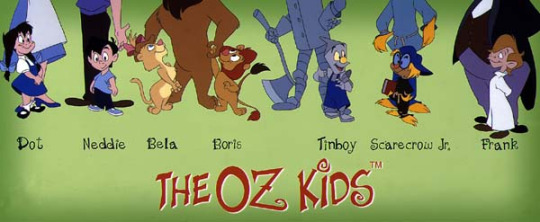
1997's The Oz Kids
A direct-to-video cartoon series that is just what it says. We follow the adventures of the children of the various protagonists of the Oz novels. Dot and Neddie, Dorothy's children ; Bela and Boris the children of the Cowardly Lion ; Tin Boy and Scarecrow Junior ; the son of the Nome King, and more...
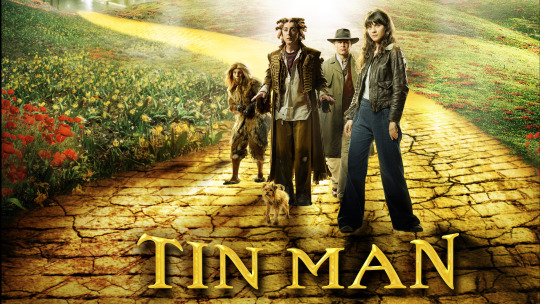
2007's Tin Man
Ah, Tin Man! A cult-classic a lot of people remember fondly - especially on Tumblr. This mini-series was part of the long suite of SyFy "dark sci-fi" fantasy reimaginings (2011's Neverland ; 2009's Alice, etc).
Described as an "adult steampunk reimagining" of the Wizard of Oz, it depicts the adventures of DG, a waitress of Kansas, as she gets taken by an interdimensional storm to the otherwordly "Outer Zone", and there befriends a telepathic leonine humanoid, a man who lost half of his brain, and a former cowboy-like law enforcer of the dictature a wicked witch-queen set upon the Outer Zone...
Speaking of steampunk, the last two Oz adaptations I want to talk about are...
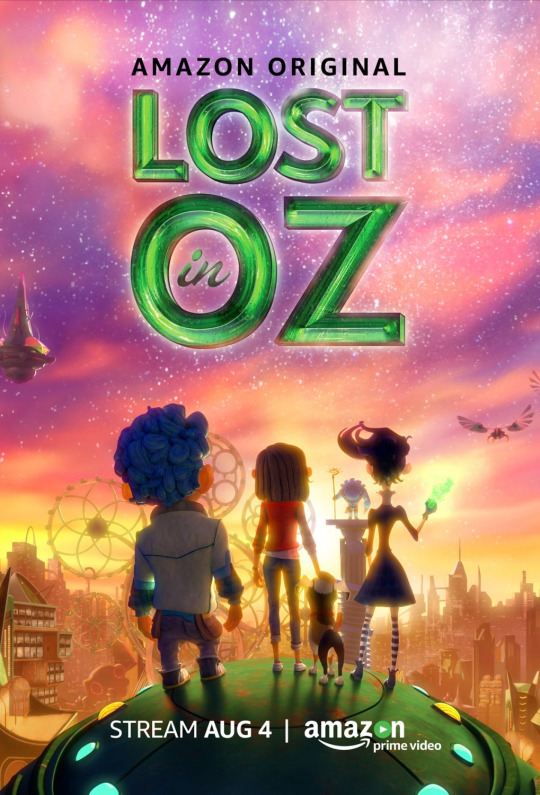
2015's Lost in Oz
This animated show was part of Amazon Prime Video early days at producing its own content. Originally it was just a pilot episode released in 2015. Since the pilot episode proved good, it became a three-episodes mini-series in 2016. Since THIS mini-series proved good, it became a full season in 2017. And since this first season proved good, a second season was released in 2018. And then they stopped.
At first it seems that this show is just an "updated" version of The Wizard of Oz: Dorothy and her dog Toto gets transported to the Land of Oz, and must find a way to get back home while making friends and all together fighting through the many plots and scehmes dividing the land... Except that this Oz is a more modern and updated Oz filled with magi-tech, and Dorothy's companions are not exactly your traditional band... Turns out Dorothy has to team up with Ojo, here depicted as a "giant Munchkin", and a teenage witch by the name of... West. Yes, she is the (not so) wicked witch "of the west".
And thus starts a quite unique retelling of Oz where the three teenagers must face various threats taken from later Oz books: Langwidere, here West's evil aunt ; the mysterious Crooked Magician ; and Roquat, the Nome King.
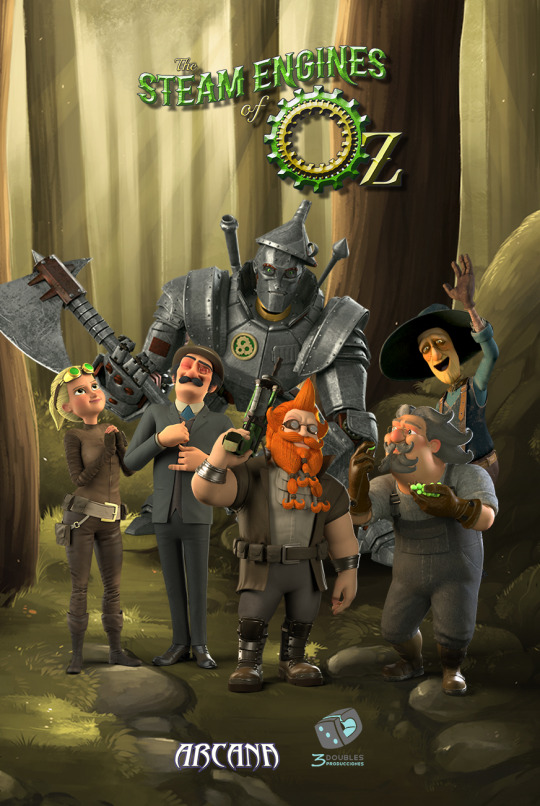
And a last steampunk Oz for the road: 2018's "The Steam Engines of Oz". This Canadian animated movie is actually an adaptation of an Oz graphic novel of the same name, by Erik Hendrix and about a modernized Oz set after the events of "The Wonderful Wizard". A young mechanician of the Emerald City, Victoria, is chosen by the Good Witch of the North to help fight the ever-growing expansion and industrialization of the Emerald City, pushed by a Tin Man who became a cruel dictator of Oz...
#oz#so you want to know about oz#oz adaptations#land of oz#oz cartoons#oz series#the marvelous land of oz#ozma of oz#the wonderful wizard of oz#tin man#emerald city#the muppets' wizard of oz#the witches of oz#lost in oz#the oz kids
46 notes
·
View notes
Text
(Part 1) Film & TV Recommendations for Halloween
1. Over the Garden Wall (Miniseries, 2014)
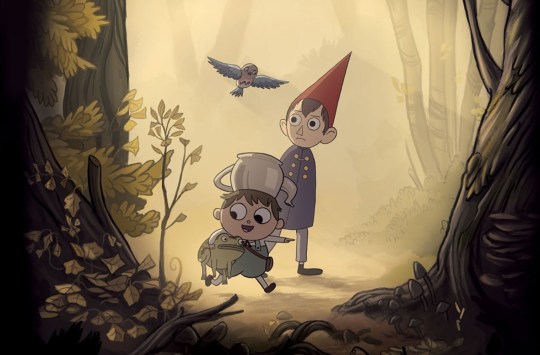
Over the Garden Wall features two half-brothers, Wirt and Gregory, who have become lost in a mysterious wood called The Unknown and attempt to find their way back home.
...
This beautifully crafted animated miniseries is the best thing to come out of Cartoon Network even after ten years. The unique atmosphere, which blends fairytale charm with Gothic eeriness, perfectly compliments the early 20th-century Americana-styled animation. At just ten episodes, Over the Garden Wall is a short but impactful experience that lingers with you long after it ends. I highly recommend this series.
2. Coraline (Film, 2009)
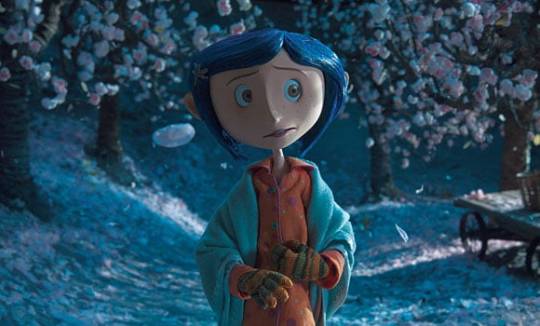
Wandering her rambling old house in her boring new town, an 11-year-old Coraline discovers a hidden door to a strangely idealized version of her life.
...
This stop-motion animated film is a deeply unsettling and visually stunning experience. Blending a dark fairytale narrative with otherworldly imagery, it presents itself as a psychological horror for young and older audiences alike. Coraline explores the complex ideas about family, identity, and the dangers of wish fulfillment with grace. I strongly recommend this film.
3. ParaNorman (Film, 2012)

Norman Babcock, a young boy who can communicate with ghosts, is given the task of ending a 300-year-old witch's curse on his Massachusetts town.
...
This heartfelt stop-motion animated film blends humor, horror, and themes of ostracization and acceptance. While blending classic horror movie tropes with a coming-of-age story, it manages to portray strong themes of prejudice by using zombies, witches, and ghoulish imagery. If you're looking for a unique spin on classic B-movie horror, I highly recommend this film.
4. Happy Death Day (Film, 2017)
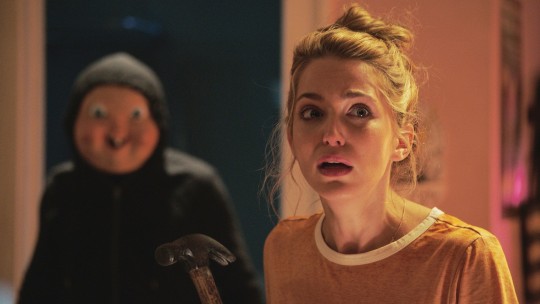
A college student must relive the day of her murder over and over again in a loop that will end only when she discovers her killer's identity.
...
Happy Death Day is an entertaining mashup of slasher horror and Groundhog Day-style time loop storytelling. This film stands out from all the rest of the horror-comedy franchise due to its emotion, mystery, and character growth. While it doesn't push boundaries for horror, it makes up for its uniqueness that balances humor and suspense. If you're looking for a horror-comedy film, I strongly recommend this one.
5. Jennifer's Body (Film, 2009)

A newly-possessed high-school cheerleader turns into a succubus who kills her male classmates and devours their flesh in order to survive.
...
Though it was sorely misunderstood when it originally came out, it has recently garnered rightful attention for its subversive take on the horror-comedy genre. This film blends teen drama and supernatural horror and uses its genre to touch upon the objectification of women in horror and in reality. Its wit, self-awareness, and social commentary have made it a standout in the horror-comedy genre, and for that, I strongly recommend this film.
6. Sinister: Recut (Film, 2012)
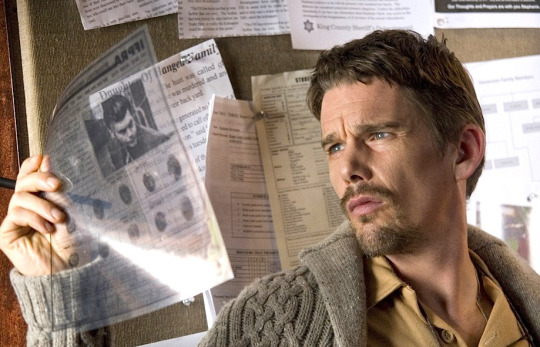
Ellison Oswalt is a struggling true-crime writer whose discovery of snuff films depicting gruesome murders and strange supernatural elements in his new house puts his family in danger.
...
Said to be one of the scariest films ever from a research study, Sinister is a deeply unsettling horror movie that perfectly mixes supernatural elements with psychological tension. The haunting score combined with the grainy, nightmarish footage of the murders results in an unnerving experience that sits with you long after you turn the lights out. Instead of watching the original movie, I strongly recommend this fanedit version of the film. It elevates the movie by removing some of the cheesy jumpscares and awkward dialog. If you're looking for a genuinely haunting movie this Halloween, I recommend this one.
7. 1408 (Film, 2007)
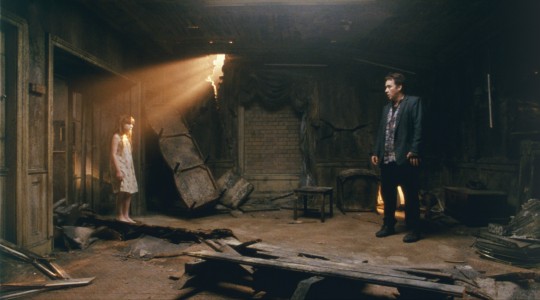
Author Michael Enslin, who specializes in debunking paranormal occurrences, checks into the fabled room 1408 in the Dolphin Hotel in New York City.
...
This film excels in building suspense, using minimal special effects, and relying on our main characters' isolation and psychological unraveling to create fear. While this movie isn't as overtly terrifying as other horror films, 1408 offers an eerie, slow-burn experience, blending supernatural elements with personal trauma. The film has two different endings, the theatrical version and the director's cut. I'd suggest watching both to come to the conclusion of your favorite. It's a must-watch for fans of psychological horror, and I strongly recommend this film.
8. Midsommar (Film, 2019)
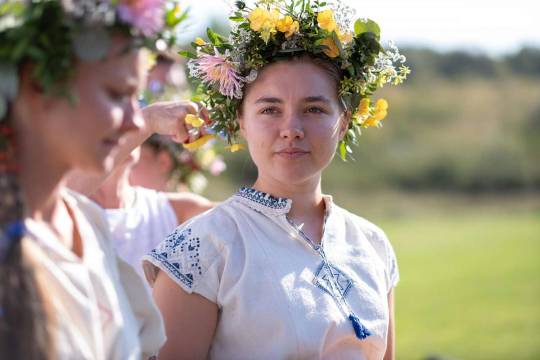
A couple travels to Northern Europe to visit a rural hometown's fabled Swedish mid-summer festival. What begins as an idyllic retreat quickly devolves into an increasingly violent and bizarre competition at the hands of a pagan cult.
...
This is a visually stunning and disturbing horror film set against the backdrop of a bright, idyllic Swedish village. The movie stands out for its unique approach to horror, unfolding almost entirely in daylight, creating a sense of unease through its striking visuals, unnerving atmosphere, and slow-building dread. Midsommar is a polarizing piece of media, mixing folk horror with psychological drama, and is filled with symbolism and unsettling imagery. I highly recommend this film if you're looking to be disturbed this Halloween.
9. Skinamarink (Film, 2022)
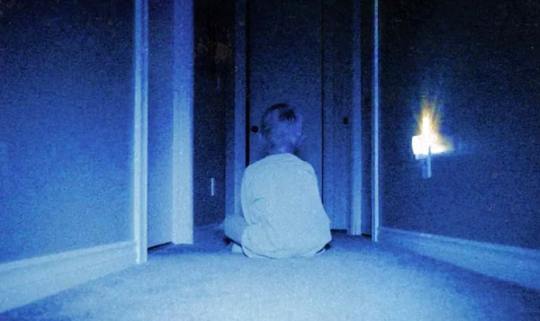
A young brother and sister wake up during the night to discover that their father is missing and that the windows, doors, and other objects in their house have vanished.
...
Skinamarink is an experimental analog horror film that trades traditional narrative for a surreal, nightmarish atmosphere. Shot in grainy, low-light cinematography, the film immerses you in a disorienting and eerie world where fear of the unknown takes center stage. The film’s strength lies in its ability to evoke childhood fears, using abstract visuals and unsettling sound design to create a sense of dread. However, its unconventional approach may alienate some people who expect a clear plot or resolution. The minimal dialogue and deliberate pacing make Skinamarink more of a mood piece than a traditional horror film, relying on atmosphere over jump scares. For those willing to embrace its experimental nature, Skinamarink offers a haunting and disquieting experience that lingers long after it ends, tapping into primal fears of isolation and helplessness. For all these reasons, I highly recommend that you check out this film.
10. Heck (Short Film, 2020)
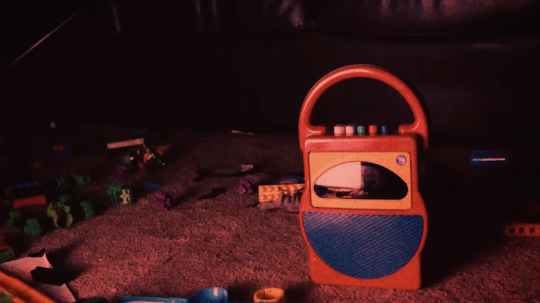
A child wakes up in the middle of the night to the sound of his mom's television blaring.
...
Heck is a short film that shares a similar atmospheric approach to the creator's feature-length film Skinamarink. Like Skinamarink, it explores the feeling of being trapped in a surreal, dreamlike space. The film's minimalist aesthetic, with grainy visuals and a haunting soundscape, creates a disorienting atmosphere that leaves much to the imagination. It builds tension through its slow pacing, relying on the viewer's discomfort with the unknown rather than traditional horror tropes. For people who thought Skinamarink's runtime was excessive, Heck is a great substitute that captures the same atmosphere of the former. I highly recommend this film to people who have enjoyed Skinamarink's take on horror.
#movie recc#movie#movie review#movies#tv reccs#tv recommendations#tv review#tv#tv shows#movie rec list#movie recommendation#film reccs#film recommendations#film#films#horror#horror film#horror review#horror recs#halloween#all hallows eve#happy halloweeeeeeen#coraline#paranorman#scary movies#halloween movies#happy halloween#spooky month#spooky season#otgw
21 notes
·
View notes
Text
I woke up this morning and the very first thing I did was watch the next Madoka Magica movie trailer, I will now provide an extensive (and probably excessive) analysis. I'm going to be as thorough as I possibly can and that's a warning! <3333
The phone ringing sound effect at the start is the exact same as the one in Akumura's transformation in magia record (april fools one) (side note this is how I found out Devil Homura actually got into magia record, I saw the transformation and I am so mad)
after that IT'S THE LIZARD :DDDDDDD
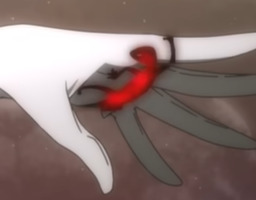
very happy to see the Homura lizard I think she's important <3
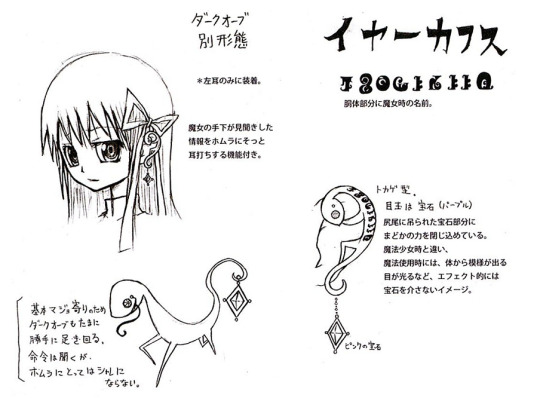
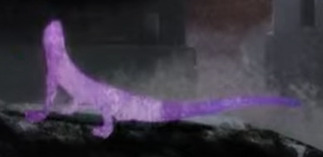
Translating the ear cuff concept art (google translate so probably not too good a translation but bare with me) the jewel attached to the tail is Madoka's power which is neat, the madoka runes also say "Homulilly" if you're wondering.
The new lizard is a similar representation to the purple one, I believe the lizard is a representation of sorts for her love of Madoka (note how it splatters. My theory is that the lizard is Love, that's why Love didn't show up to Homulilly's funeral.)
It's red either to show it's corrupted or because as aforementioned Homura possesses Madoka's power in the gem her ear cuff carries (that's also why I think her eyes were tinged pink in the Devil Homura form)
The lizard turns into a phone so we'll probably have a pretty good excuse to make Homura Touch Tone Telephone amvs/animations, yippee!

A lot of people have pointed this out as a tarot card meaning illusion, fear, subconscious, etc which definitely fits. I want to add on to this scene though: around the centerpiece there's butterflies with pins through them, in her magia record "coolmura" transformation her glasses turn into butterflies so it might be a callback relating to that.
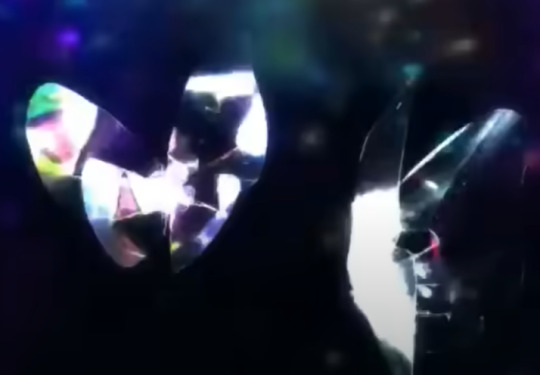
(In that transformation they go into her soul gem, in this scene they're pinned down, something about lizards eating butterflies? And butterflies representing freedom, the butterflies being pinned then definitely matches what she does to Madoka at the end of rebellion.)
The moon symbol halved like that is also used various other times in the series too, in one notable instance she was even sitting under it like she is in next shot
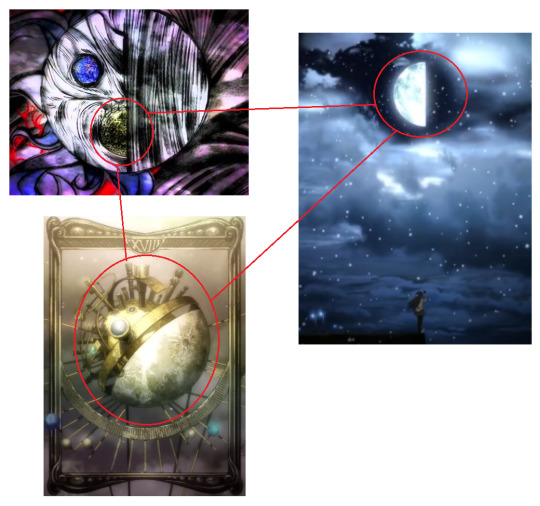

LIZARD AGAIN WOOOOOOOOOOOO LET'S GOOOOOOOO
Homura gets a pretty new outfit and cool lizard chair good for her tbh

Zooming in I can see that 1: Homura's outfit slays even harder than I thought it did (and it's very similar to the one she wears mid witch transformation in rebellion) 2: the chair is supposed to look like her devil homura form and 3: the lizard she's sitting on has the gem eye so it's probably at least related to the ear cuff

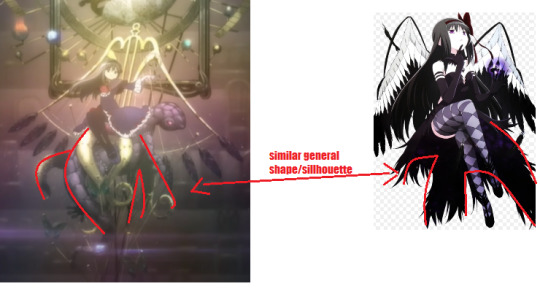





Skipping ahead through the montage, there's this girl

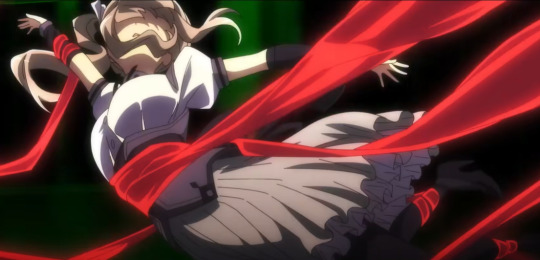
Who the HELL is this. Her outfit looks a lot like Homura's, she even uses Homura's bow and arrow, but it also looks like Madoka's? Like some sort of mix between the two. Even weirder, the ribbons she seems to be fighting with look like MAMI'S. What, does the new movie have magical girl fusion? Is this Hitomi somehow? Is it Mami? Or someone new?
Here's what I think: Homura takes the place of Kyubey in turning people into magical girls, this is one of the girls who she made into one. It makes sense for why she was saying "can you accept the risks and responsibilities? Can you fight against the curse of this world?" Maybe, people contact her through the phone asking to become a magical girl and that's what she says to them. This girl also appears right after the phone hangup noise.
Next, there's this scene. Which... is a little concerning.
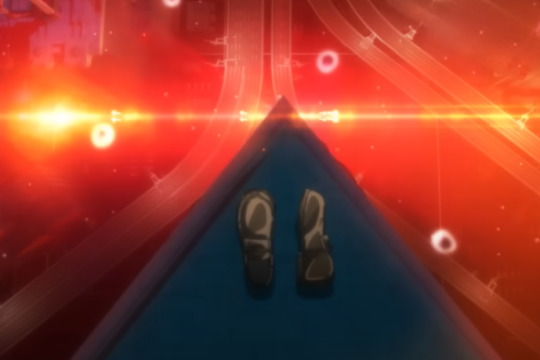
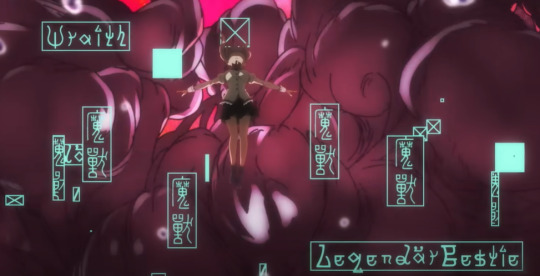
There's some pretty unfortunate conclusions you could draw here, but look at the digital stuff around her. Is Madoka going to the endless solitude? Remember, to get there you jump off of the radio tower alone. (To be honest, it's been a while since I've seen magia record because I don't really like it, and I haven't seen season 2, so I wouldn't be surprised if there's some gaps so if there's anything from magia record that could add to the analysis I'll leave that to the fans of magia record)

Homura looks so pretty oh my god. New headband, also she's carrying an umbrella
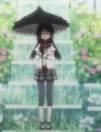
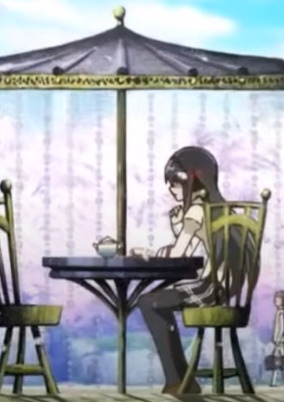
she had one in rebellion too but this one's cooler. Also it looks like she wears pants under her skirt now! Getting some fun design changes to shake it up I see.


Kyoko and Mami got pretty slight design changes, Kyoko looks exactly the same so I'm not actually sure if anything changed and Mami's top looks pretty different. Nothing to say about that except, cool!
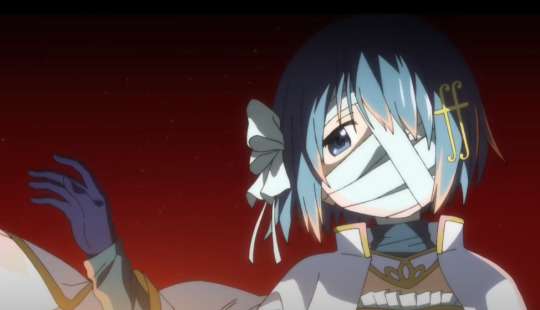
Sayaka looks pretty majorly different though. She now has a ribbon wrapping all over her face. Probably something about how she knew about Homura being the devil, this might be symbolism for her being silenced. Either way it's also cool.
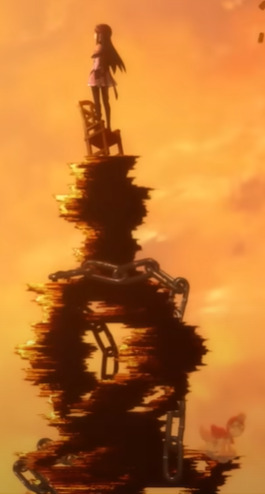


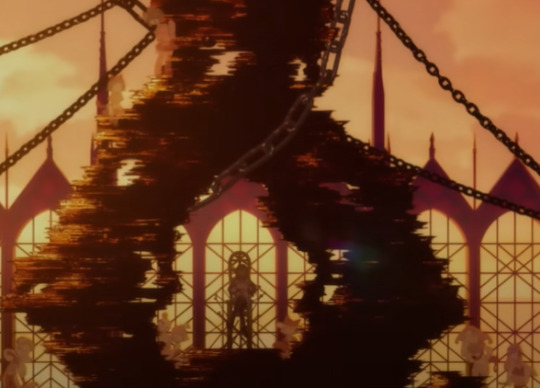
After that Homura's on this really tall tower, somehow there's more than one of her. If you look at the backdrop you can see the fence on the roof of the school.
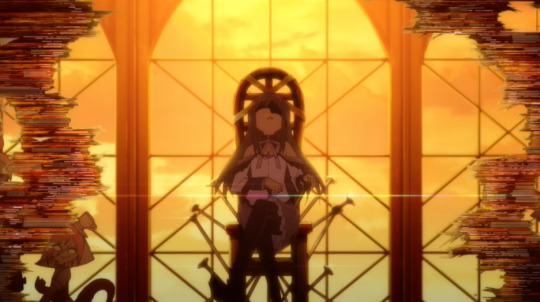
Zooming in, the tower is apparently built up of books. Behind Homura there's some nails, they look sorta like the needles in the first scene. Something interesting is she's wearing her usual magical girl outfit, except with the shawl and brooch from the first scene. The Clara doll also sorta looks like a lizard tail.
And that's the trailer! Hope you enjoyed my spiral into insanity, it took me two hours to write this :D
#madoka magica#puella magi madoka magica#akemi homura#homura akemi#madoka magica rebellion#walpurgis no kaiten#pmmm#pmmm homura#pmmm madoka#pmmm rebellion#pmmm rebellion sequel#AUTISM🔥🔥🔥#long post#like really really long post
85 notes
·
View notes
Text
The Gift (5a of 15) (Witch Steve AU)
previous: Chapter 4 Break the Illusion next: Chapter 5 You're Doing That On Purpose (Part B) Content: steddie fic, 1.4K words
Last chapter, Steve and Eddie came to an understanding and formed a deeper start to their friendship. This chapter, Eddie just wants to convince Steve about which film to watch on movie night and Robin's gonna mock Steve about the two of them flirting.
Chapter 5(a) You're Doing That on Purpose
“So, it’s a kid’s film,” Steve pushes the trolley down the aisle to the comedy section.
Eddie makes a sound like a whistling kettle and Steve bites down on a grin. Behind the counter, Robin ignores the both of them as she tries to plait three Twizzlers into a braid.
Despite school being out, Family Video is as empty on a Tuesday afternoon as it typically is, so no customers to judge her odd candy habits. The promo television silently plays Carey Grant's attempt to seduce Rosalind Russell in His Girl Friday while Robin unironically plays the Bangle's Manic Monday on their shared boombox. The tinny sound provides a lively chorus to the boys' bickering.
“It’s a cult classic of epic proportions. It’s not just some animated film, Stevie. It tells of the enduring friendship of Frodo and Sam, it’s the journey from the Shire and the almighty and devastating battle of the Balrog.”
“Right,” Steve snaps his fingers absently, “the Shire is burning.”
Eddie eyes him oddly, “You remember that?”
Steve shrugs, “It sounded cool when you said it. I mean, I didn’t know what you were going on about, like the Bolrag too.”
Eddie squints at him, “You’re doing that on purpose.”
Uh, oh, busted. Robin meets his eye from across the room, laughing silently. They have a running bet on how long he can mix up fantasy names in front of the kids before they call him on it and Eddie had busted him within weeks of knowing him.
Steve feigns innocence while he shelves Weird Science onto the fake walnut shelves, the polished lamination suiting the glossy covers of the VHS cases. “I don’t know what you mean. Tell me about the Shire.”
“No, no, no,” Eddie sways into Steve’s right side, tugging on a lock again. He’s almost used to it now. Regardless, Steve bats his hands away, replacing the shock of Eddie's fingers by smoothing his hair back into place.
“You, my friend, pay attention. You know exactly where the kids are at any moment of the day, you listen to little old ladies at the Indy bookstore—”
“She wasn’t old,” Robin calls out. She was hot, he can hear her add silently. He nods at her to acknowledge how right she is. Her fist pumps in answer, she was hot.
Steve had told Robin that Eddie was safe and since then they'd all had a conversation that essentially amounted to each of them nodding in agreement: they were three queers in backwater Hawkins and, damn, wish that they’d known each other sooner.
They'd had the talk in the evening quiet of the local park, the heat of the day faded to a gentle breeze that carried a hint of the earth underneath them.
While Steve and Robin kicked a ball around, Eddie had sat, nestled within the sturdy and gnarled roots of the massive fig tree at the centre of the grassy area, working at the lyrics of a song. Of which, he refused to share with Steve and Robin, only smiling mysteriously when prodded about it.
Despite the black of his cut-off jean shorts and the grotesque skull on his t-shirt, the soft curls of Eddie's hair and his pensive expression as he looked down at his notebook had given Steve the impression of an earth sprite. Delicate and easily startled, ready to disappear into the trunk of the fig tree, never to be seen again.
Once the two players had tired themselves out a little, Steve had sat them all down and led the conversation under the shade of the broad leaves above them. The green of it stretching like fingers of a reaching hand, cradling them within its protection.
Steve had been amused at how shocked Eddie was, a near replica of Robin's reaction to his same disclosure last year. But, what was the fluidity of Steve's sexuality in comparison to the liminality he lived in as a Witch? He liked boys and girls and all in between. So, what? He could also make Robin hover by a few inches in the air and that was far more fun to play around with.
The conversation may have been had, but Robin wasn’t about to loudly call out something so damning in public when anyone could walk through the store door at any moment in their small, judgemental lives.
“—and I know you’re getting those names wrong on purpose,” Eddie concludes confidently.
Steve crosses his arms, biceps bulging slightly under his sunflower yellow polo. “So what if I get Bolrag wrong? I don’t want to watch a kid’s movie.”
Robin hums. “Always the babysitter.” Steve points to her in appreciation.
“No kiddies, I promise.” Despite being the same height, Eddie looks up at Steve through his bangs while his dimple deepens charismatically, “Just us big kids. You’re in, right Buckley?”
“Oh yeah,” she smirks at Steve, “it’s actually pretty good. And Eddie says it’s that or Ben Hur.” She makes a face.
“Isn’t that a black and white,” asks Steve teasingly, knowing her preoccupation with older films.
“No, it's colour, but I also don’t want to watch a flick about the boiling animosity of half-naked men for over two hours. Come on, Steve, let’s watch the kid’s movie that’s just under two hours,” she finishes sarcastically.
Eddie’s lips quirk crookedly, “The bonds of men and Hobbits alike are the theme of the night.”
Steve blows out a breath, knowing when he’s defeated. By the widening smile on Eddie’s face, the other boy knows it too and Steve can’t help but smile in response.
He’s aware that it’s been hard for Eddie lately. Beating the rap doesn’t mean squat when Jason Carver and his goons still have it out for him. Though Hop had apparently reigned the parents in so hard that their evil little offspring may have actually listened. Steve suspects that Hop had also pulled off one of his patented 'drive arounds' with the teens, calmly explaining the consequences of their future actions and, in turn, scaring the shit out of them.
The kids had shared about Jason and his guys stirring up trouble at school, but it sounded like it was mostly name-calling at this point. Steve had made Dustin promise to tell him if it got worse, but Eddie hadn’t said anything yet.
Steve pauses to consider before cautiously asking, “And the bonds of Hellfire? Is that staying strong post…” Steve waves his hand in the air as if to convey all that happened over Spring Break, including being hunted down and having your friends threatened by Jason’s vigilante mob.
An easy smile spreads over Eddie’s face, his voice rising as if performing to a larger audience and hands spreading wide like he’s inviting them to step onto his stage. “Hellfire? We are as strong as any dogs of war. For while our bloodshed is confined to the realm of the sorcerous, we still are that happy few, we band of brothers.”
Steve’s not one hundred per cent on what Eddie’s referring to, but he does trust that they’re getting along okay. He doesn’t have that tightness around his eyes and lips he sometimes gets when uncomfortable or avoiding a touchy subject. “And Jason? Is he leaving you alone?”
Eddie blinks for a moment, his wide smile dipping before drawing it back firmly onto his face. “No problems there, Stevie. They can’t do anything and I’m not worried.”
Steve is though, thinking about that brief expression hinting at more. But, he wonders what he’s allowed to question. Or maybe, he is allowed to ask Eddie, who may nevertheless still choose not to privilege Steve with an insight into that busy mind of his.
“All right, then. Since your band of dogs are happy, let’s do the hobos.” He feels a flash of triumph as he hears Eddie’s bark of laughter at Steve continuing the bit. “My place, Friday.”
“Fantastic my lovely, dear liege,” Eddie affects a bow. “I’ll shall bring the brews. My Madam Buckley, farewell.” She sticks her middle finger up at his blown kiss. Eddie leaves, chuckling under his breath, the door’s bell ringing after him.
If you liked anything, please consider leaving a comment over on Ao3 :-) It would make my day!
Taglist
My taglist is always open, so let me know if you want to be added. Likewise, if you want to be removed, let me know. :) If I've missed you, definitely tell me because it's an accident!
@a-gae-af-racoon
@a-lovely-craziness
@aly-reads-alot
@bookworm0690
@cinnamon-mushroomabomination
@ellietheasexylibrarian
@everyrandomthing
@finntheehumaneater
@geekymagicalpotato
@goodolefashionedloverboi
@hallucinatedjosten
@ilikeititspretty
@just-a-tiny-void
@ledleaf
@littlewildflowerkitten
@lostonceandneverfound
@manda-panda-monium
@matchingbatbites
@mightbeasleep
@nburkhardt
@newtstabber
@obliosworld
@oliver-sykes
@platonicbesties4life
@probablyscreamingintothevoid
@rajumat
@scoops-stevie-archive
@spectrum-spectre
@swimmingbirdrunningrock
@tartarusknight
@whackyrach
@bestwifehaver
#witchsteve#steddie#platonic stobin#any unexplained references are detailed in chapter notes on Ao3#stranger things#steve harrington#eddie munson#paperbackribs writing
64 notes
·
View notes
Text
Mouthpiece TTCC Headcannons‼️‼️‼️

Staring off strong I think she can fight, if someone were to start a genuine fight with one of her grandkids (or even her coworkers she sees as her grandkids) she would be fighting in second. She can pack a punch and she’s not afraid to put some force behind it either. (She’s been written up because of this). [more under cut]
Belle, her house is full of trinkets, stuff she’s knitted, things her kids/grandkids have got her, her house also always smells like cookies. Even if there are no cookies in sight her house is warm and smells delightful.(This causes like an army of bugs because it’s warm and smells nice.) However if you were to spend the night you couldn’t work the shower because it’s too confusing and has a 50 step tutorial to get it working.
She indulges in sweets sometimes (a lot) so she is constantly giving them away so she doesn’t eat them all. (She has a really big sweet tooth.) Belle even makes toon friendly sweets because arguably toons have such sweet food and candy she loves it. Give her jellybeans and she’s celebrating.
Breaks things so often, like I’m talking about if she holds it, it’s broken. She refuses to hold things for anyone because of this.
Wins at every board game possible, if she plays you’ve already lost because of this she’s banned from company board game night after she beat the Chairman over a game of monopoly.
Belle loooves hallmark movies, if there’s one she’s seen it. She knows the name of everything, character, town, even the names of the rich ceo. She can recite the movies word for word, she can even make the same expressions and she can sound exactly like the actors to the point it’s crazy. People have asked her if she had ADHD but Belle gets confused and just says she really likes the movies. She’s met each actor, writer,crew person,director, and even the animals they use during the movie. She runs the fandom wiki and it’s so detailed and only she runs it. People have been doxed if they try and mess it up.
Because Belle is old people have just assumed she didn’t know what the LGBT community was [Skull emoji] and so she wasn’t invited to pride, so when she showed up Misty wanted to know if she supported. Let’s just say that people know she’s a Bi icon and trans fem.
Following up on that everyone in her family is trans, when Belle was little she got a spell cursed that every family member after her would have the same issue as her (The issue was being assigned a different gender at birth.) and now everyone is trans. (The the wizard who cursed her was Witch Hunter. Suits also have only two things change with sex, your Build how feminine it Masculine it is, and your voice but you can always mix it up so gender and sex are very loose words to suits.
She is afraid of dying, okay real depressing right? So the reason she flies away after you beat her is because Belle is terrified, She has this idea that if she were to explode they couldn’t fix her because her parts are so old. (This fear is totally irrational and she goes to therapy for it.)
I think Belle is a professional yapper. If you put her Benjamin and Flint in a room together they could probably talk for 3 weeks straight. I also think she’s sassy, everything she says does have a purpose and she’s constantly thinking on the correct things to say. One time she ended up reciting an entire Hallmark movie because Benjamin and Flint let her.
She vocal stims, if a phone can make that noise so can she. She’s actually the reason phones ring because she just kept saying “ring ring ring.” When she called people.
Belle loves sappy music if it’s romantic she knows it, she knows the dance to it. Also she’s definitely the queen of telling you she’s met your favorite band in their prime.
She kills it on piano, she can play Rush E at the highest possible tempo ever and she knows every single song without using sheet music, when Belle was younger she always won piano competitions because she was just that good. So when you use a piano drop on her she will target you for trying to break her with her favorite instrument.
Everyone knows Cassie is Belles favorite grandchild and nobody can disagree because Cassie is an angel.
Belle a lady of color, she’s mixed Egyptian and Italian and she loves her cultural foods and she loves her food spicy and flavorful.
———
Belle actually got Flint and Graham together after hinting it. She’s actually the reason most workplace relationships work out, she plays Cupid and valentoons day is her favorite holiday because of this.
I think Misty is still growing, (Despite her being in her early twenties.) but Belle will squeeze her cheeks and tell Misty how how big they’re growing and definitely give her twenty cog bucks as a gift.
She has an advanced vocabulary and she taught Brian words he knows. He often challenges Belle to puzzles and sudoku to better learn words.
Belle and Cosmo are both Italian just Belle is an third generation from an immigrant family and Cosmo is the First generation. Cosmo teaches Belle Italian and they can communicate in it, Cosmo has only come out to the satellite investors and Belle about how he’s Trans masc. Also Belle now tells Cosmo the Hallmark movie scrips in Italian.
Belle was worried about Cathal and Tawney because no suit should be sleeping that much so she genuinely asked if they were depressed, turns out they take their shifts during the night so it appears they are always sleeping. She felt really embarrassed so Belle baked them apology cookies and Tawney and Cathal stick to her like glue. Belle often gives them both super soft blankets she knitted herself so they can sleep comfortably and she is the one who packs Cathal his sandwiches (She has no idea why me needs so many.)
Belle loves giving Buck duck trinkets from the flea market, and Buck reminds her of her grandson with ADHD and so she often is able to keep Buck from overstimulating everyone around him. (Cosmo greatly thanks her for this.)
Belle is a mother figure to Spruce and Chip, she genuinely thinks they are blood related brothers and often treats them like such. They don’t have the heart to say they are just close friends since childhood so they play along. Belle was the first person Chip told about the override and she sticks by his side hugging him and keeping him grounded. (The override never activates when he’s around her because of this.) Belle is very concerned for Spruces help because she only sees him eating trees. She made tree shaped cookies so he would eat them and makes special accommodations to his food so they are all trees.
Belle refuses to leave Flint alone after he somehow exploded her oven and burnt the charcoal-chunk cookies. She watches them like a hawk and is genuinely considering giving Flint a wellness check to see if he has Pyromania. (They do.) She also makes special burnt cookies just for him so They can enjoy.
Belle makes time to see each and every one of Dave’s concerts, (she even convinced him to make a Hallmark play and everyone loved it.) She is his (second) biggest fan right next to Buck. And she always buys Dave flowers and he keeps them in a little vase in his dress room.
Belle and Graham have very different ideas of music but they do have an entire album together of a wonderful blend of Rock and Old-Times music and they even won 6 Grammy awards for the album and they won best songwriters of the year. (Flint is also on the album because them and Graham are inseparable.)
Her head can call people like a telephone so she uses it when she needs to call. And only call she can’t text because it hurts her head (It also burns into her brain.) Unfortunately she can’t whisper so she only has the most important calls in her home. Buck often spam calls her because he’s already told Brian something twenty times. (Belle is very close to blocking him)
If all the managers where put in a room Belle would be able to get everyone working together and having a fun time, she’d make everyone comfortable and that’s why parties at her house during the holidays for this group of managers (And the Satellite Investors.) is exciting and wonderful and everyone often looks forward to the holidays because of this. (Expect when it’s Hallmark movie time and Belle gets to exited over these movies and keeps quoting the most outlandish things ever.) Belle would take the managers on vacations too and separate them into groups to make sure everyone can handle eachother and no fights break out. She also makes sure she only picks trips everyone can enjoy and so far she hasn’t had any complaints (yet.)
I don’t think she swears a lot but when she does. The first time she genuinely got mad was when someone had broke something her deceased mother made her. Let’s just say everyone was shocked but realized it’s better she doesn’t keep her emotions inside all the time. Belle will cuss when she’s singing or just when she’s in extreme shock or anger. She however won’t curse in-front of a kid because she’s a parental figure.(she will freak out if she slips up and the kid won’t stop repeating the word.)
#silly little guy#belle dama#mouthpiece toontown#toontown#headcanon#headcanons#erm what the flip#ermmm what the scallop#ttcc
23 notes
·
View notes
Note
Hello! If you're still doing them, could I please get a Baldur's Gate 3 matchup? I hope you don't have too many, I know that matchup requests tend to pile up very quickly so I apologize if you already have a lot.
Irl I'm AroAce but I am attracted to fictional characters, so any gender works for me. I am also genderfluid (she/her is fine), autistic and disabled with joint pain, asthma and sensitivity to cold. I'm a professional librarian, witch (and pagan, I write a lot about both things), herbalist/ethnobotanist and athlete. I really enjoy working out and getting big muscles, and I'm thinking about competing in either the Highland Games (at my state's Scottish festival) or the Paralympics. I have to be really careful with my breathing when working out and stuff because of my asthma, but I'm very stubborn so I make it work somehow lol. I'm a really odd mix of athletic and scholarly - I'm a librarian and I love plants, I can name almost any plant I find on the side of the road, but I also really enjoy being strong and impressing people with my muscles. I like to describe myself as an irl Shounen anime protagonist - I'm very spunky and determined, like if I'm going to be a witch or an athlete I'm going to be the best witch or athlete. I'm a little perfectionistic in that way but I also know when I need to take breaks.
I love plants, I have a myriad of houseplants that I care for very deeply, and I also really enjoy cooking and baking. A big fact about my appearance is that I’m very short, I'm under 5’ (152 cm). I also have really wavy long auburn hair, glasses, big muscles, and I love collecting shirts and clothes that I think are funny. I once bought a really ugly pair of pants because they were called “gamer pants” and I found that hilarious. I'm basically if a girl was also a lame boyfriend and I love it. I'm generally a little confident and I like who I am, but I get anxious and awkward sometimes. People are actually a little surprised by my real chaotic personality because I usually put up a pretty sweethearted demeanor so they get caught off guard by some of my antics. That being said, I genuinely adore taking care of people and I like being nice to others. I’m also both a walking trivia machine and a himbo, so I know tons of facts but can’t figure out how to turn the wifi on lol. I really just do my own thing and I don’t keep up with pop culture or trends, so I’m clueless about most movies and series and things.
Sorry if this is too long, I got a little too into it lmao! I hope you’re doing well, and thank you!
The AroAce-but-not-for-fictional-hotties (/j I cannot emphasize that enough) army is growing. We will conquer and we will kill.
== Baldur’s Gate 3 ==>
I match you up with…
Karlach
Pre-relationship:
You and Karlach get on from day one. Your kindness gives her a sense of belonging amidst the morally grey characters in the party, and yet your chaotic tendencies make her laugh like no one else.
Thus, she’s pretty smitten with you from day 1.
She also likes that you’re intelligent and strong - you’re everything rolled up in one dorky package that she deeply admires.
When you wrap up her wounds after she gets injured, you can practially hear her infernal engine exploding with emotion.
She’ll constantly ask you about the plants you find, amazed you can identify them. She’ll make you bouquets of the nicest flowers she sees, and it’s all so terribly romantic.
Confession:
Karlach tells you how she feels point blank, but in a nice, private setting with some flowers for you. She wants you to know how she feels, and she isn’t afraid of that at all.
Relationship:
You two are a force to be reckoned with on the field. You both knock in goblins’ heads together and look into eachother’s eyes lovingly as you do.
She likes your penchant for wearing silly clothes. She enjoys that you are so put together and confident, but also that you let yourself be silly and whimsical at the same time.
She’s always there to help you when you feel awkward, and there to cheer you on while you tear up both the physical and intellectual battlefield.
Y’all are perfect for each other, enough said.
5 notes
·
View notes
Text
A Spooktacular Witch’s Brew: The Real Magic of Scary Godmother
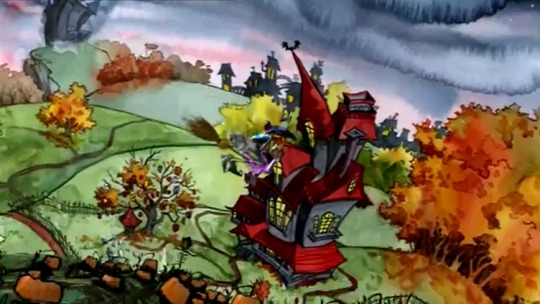
It's that spooktacular time of year where the magic and the mundane merge once again for a night of tricks and treats! Just what is it about the Scary Godmother movies that makes them such an enduring cult classic?

The Part Where We Act Like This Is The Inspirational Personal Essay On A Recipe Blog
As someone who has always loved the spooky season and held a fond place in my heart for Halloween, I was drawn to stories – particularly movies – that suited the occasion. To name just a few: the Halloweentown movies, Hocus Pocus, The Little Vampire, Twitches and its sequel, The Nightmare Before Christmas, and of course Scary Godmother were all top of the very long list.
Perhaps not-so-surprisingly, as I revisit these tales from my childhood I’ve noticed that they seem to share common themes. Families or found families of outcasts celebrating their individuality in an environment that seems hand-crafted for them, often using Halloween as a time to openly hide in plain sight during a merging of two different worlds (the magical and the mundane) and ultimately fighting for their right to coexist when a closed-minded force threatens to destroy them. As I engaged with these stories growing up, I often found myself feeling like I was coming home just as the protagonists did when they embarked on their journeys of self-discovery and acceptance.
My own personal journey with the season has been a bit of a bumpy one. For the majority of my childhood, I adored the idea of getting to dress up as whatever I wanted to be and live out a magical fantasy. Once I reached my teenage years and struggled to understand who or what I was through the extremely confusing “socially-acceptable” lens of my peers, Halloween suddenly became the one day I felt like I could wear a costume and be as weird as I wanted to be because no one could judge me for it. Then depression soon hit me like a sack of bricks and that spark of joy the season had brought me began to wither away, the only saving grace being that I could still watch the movies I’d grown up with and feel at least a little like I was home again in my own skin, though I longed to be a part of those worlds instead. Now, a decent way into my adulthood, I have started to return to my roots and discover an even deeper appreciation for the occasion.

The Recipe For A Halloween Cult Classic
Scary Godmother started out as a hybrid comic-novel book series created by Jill Thompson for her niece as a way of spreading the Halloween joy to readers of all ages in a market that she felt was lacking the material. Two of her original stories were adapted to the screen in 2003 and 2005, both of which received her supervision and guidance during the creative process.
Step 1: For a unique and easily identifiable look, toss two art styles in a blender and pulse until satisfied. Be careful not to over-blend!
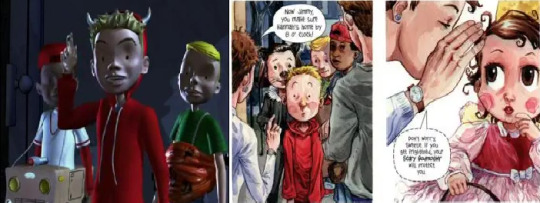
Mom says it’s Hannah’s turn with the eyes!
First things first, we have to address the elephant in the room: The mix of CGI models on 2.5D backgrounds is wild to look at and the internet has been abuzz with reviewers, reaction channels, and casual viewers alike commenting on how hauntingly unsettling it is. They point out the soullessness of the eyes on many of the human characters. There have been frantic questions about why the movies weren’t animated in 2D like Jill Thompson’s beautiful storybook illustrations. Was it only because CGI animation is quicker and cheaper to produce?
Luckily for our curious minds, the answers to these questions are simple. This was Jill Thompson’s vision!
The movie designs are accurate adaptations of her original illustrations and in fact the CGI was her decision. When discussing how to approach the style of the movie, she specified that she did not want live-action and she absolutely did not want 2D “because I’m doing 2D. Nobody else should be doing 2D, just me.” (Yes, she really did say in a Comics Bulletin interview that that was her reason. No, I’m not sure I understand it either.)
Perhaps a 2D animated movie would have looked less jarring, but I’ll say it – these movies are extremely charming in a storybook way largely in part due to that animation. The 3D characters perform highly energetic visual gags that often make them look as though they are leaping off the 2D pages of their world. Much like turning the pages of a pop-up book, it looks unreal and quite a bit magical, and may have been what first drew the attention of channel-surfing kids every year.
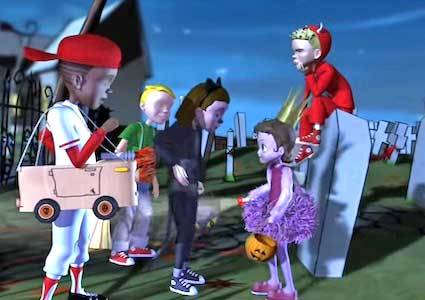
Step 2: Sprinkle in a Found Family of “weirdo” character types that you enjoy coming back to every year. Go ahead, really make it feel like a home away from home~
I always looked forward to catching this movie on TV every year because there’s something so sweet about Hannah’s found family journey with the inhabitants of The Fright Side. I mean, what Halloween-loving kid wouldn’t be drawn to a whimsical spooktakular adventure into a world of feel-good Halloween vibes? They welcome her into their home and encourage her to be her authentic self the way they live their own lives openly among friends who understand and appreciate them.
The three “broommates” in charge of the monster house are Scary Godmother, Bug-a-boo, and Skully. Their quirky trio truly is the backbone of the group.
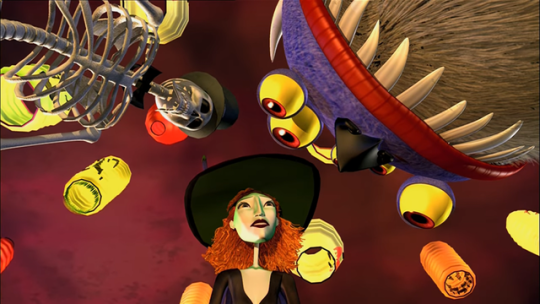
Oh my god, they were broommates.
As the monster under the bed, Bug-a-boo is the quintessential misunderstood “looks intimidating on the outside but is a huge softie inside” character. If Boo immediately getting attached to Sully in Monsters Inc. got you right in the heart as a kid, then you’ll understand what makes Hannah’s friendship with Bug-a-boo hit home. She spends the first movie steadily realizing that they share interests and favorite foods, which makes him far less scary and allows her to appreciate his fun-loving nature. When he easily breaks down all the stereotypes Hannah had been taught to believe, it becomes clear that he’s looking out for her more than the guardian she had been told to depend on. To kids who were considered “weird” enough to like monsters, this dynamic feels personal.
Scary Godmother is like the cool aunt who always has her pockets filled with candy for the niblings. She takes a no-nonsense approach to her broommates’ shenanigans, making sure they don’t frighten Hannah too much before she gets the chance to adjust to the new setting, and you just know that if you ever had trouble at home she would be there in a heartbeat to take you in. There’s something about the good witch who can be a little bit bad when the situation calls for it that strikes a personal chord with a lot of misfits.
In the human world, Skully Pettibone is a skeleton in the closet, but in The Fright Side no one is pushing him to stay in any closets! He is out and proud and extremely loud about it. In fact, the first time we see him he’s flamboyantly busting out of the closet with the dramatic flair of a stand-up comedian ready for his grand debut. Somehow, he is both too much and not enough at the same time, so you’re already expecting it by the time he spontaneously breaks out into show tunes.
Oh, and they have the most adorable ghost cat named Boozle who occasionally hacks up scareballs. I love him.
Of course they also have an assortment of friends who have been invited to the party.
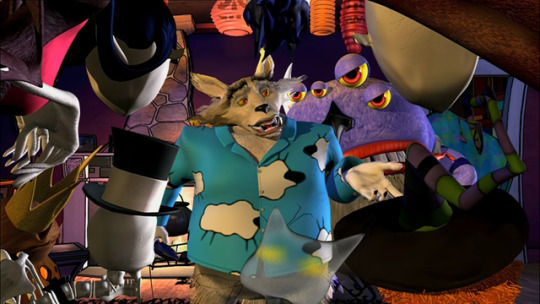
The most controversial is undoubtedly Harry the werewolf, a theater kid if you ever saw one. He is like the weird uncle who always shows up intoxicated to family gatherings (or he will be soon after he gets there), believes pajamas count as casual clothes, and has a serious case of the munchies. His fourth wall breaking humor flies over the heads of most everyone in the room and, though these facets of his personality consequently makes him the butt of every joke, he’ll read comics with you, howl at the moon, and make you laugh as he dramatically recites dialogue from your favorite scenes alongside the characters during movie night… even when he overstays his welcome.
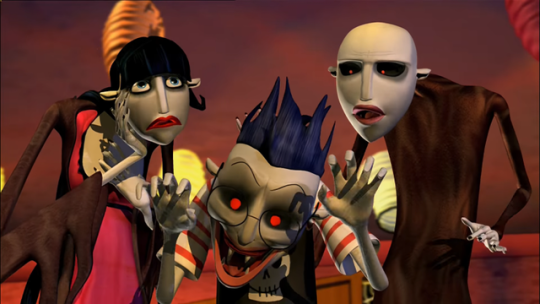
Naturally, every band of monster misfits has to include a vampire or three! Orson and his parents are the old-fashioned goth family that gives HOAs nightmares.
Max is the socially awkward Nosferatu out of time with a morbid sense of humor, reminiscing about the olden days of vampire royalty and struggling to adopt already outdated slang in order to fit in with the younger generations. Ruby is the better-adjusted Queen of the Night who finds herself caught between supporting her husband’s preference for tradition and encouraging their son’s individuality. It’s a tough job trying to get them to meet somewhere in the middle, but she has learned to go with the flow. As for Orson, he is the stand-in for every kid whose parents unintentionally embarrass them in front of their friends with cheesy jokes and an awkward amount of affectionate doting.
Step 3: To build the plot, mix 3 parts sugar for your Pure-hearted Hero with 2 parts spice for your Unrelenting Bully and voila! If the Bully gets comeuppance and Good prevails, you’ve done it right! Don’t hold back; make it cheesy!
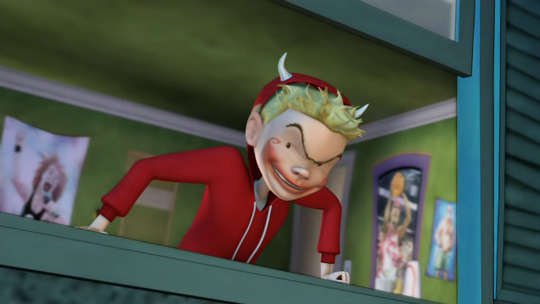
Did anyone else notice his ears got hairy? His parents let him throw out all but two pairs of clothes they never wash and his friends think he stinks… Just how unkempt IS he?
The premise for the first movie is pretty simple: Jimmy and his friends don’t want to babysit Jimmy’s little cousin while they Trick-or-Treat, so they decide to pull a mean prank to scare her by locking her in the Spook House after filling her head with tales of child-eating monsters. In response to Hannah’s tears, Scary Godmother shows up to whisk her away to The Fright Side and show her that monsters are people too!
While Hannah has the most spooktacular Halloween of her life, the older kids realize that their determination to ruin Hannah’s night caused them to miss out on all the Halloween fun they had hoped to have without her as they spend hours worrying over why they can’t hear her screams of terror from the Spook House.

The comedy lies in the eyeballs!
In the end, Hannah’s new friends help her scare her bullies in return and paint her as the brave hero of their little act, thereby winning over Jimmy’s friends for the sequel and leaving Jimmy with a full year of unresolved psychological trauma that he winds up channeling into a desire to destroy Halloween forever.
Hannah is clearly the glue that holds the entire human world together. Like many young protagonists, her wide-eyed enthusiasm for the holiday and willingness to think of everyone she meets as her friend the instant they’re nice to her is a large part of her charm. It is easy to put yourself in her shoes as she meets the denizens of The Fright Side for the first time or imagine yourself similarly solving the world’s Halloween-related problems with unquenchable optimism. She thinks outside the box and appreciates the charm in the homemade aspect of the holiday that has been overshadowed by the commercialism of the season for too long.
Someone smashed all the pumpkins in the pumpkin patch, jeopardizing that farmer’s livelihood? That’s just the mouth for their jack-o-lanterns!
Someone vandalized all the Halloween costumes and tampered with the candy in the store with no concern whatsoever for the employees whose paychecks might be at risk due to product loss? Just recycle last year’s costumes and make your own treats! Who needs candy anyway?
Someone TP’d the Spook House, littering and making it someone else’s problem to clean up later? That’s not toilet paper, that’s ghost decorations! How thoughtful!
Meanwhile, Jimmy was so traumatized by the experience from the first movie that he became a paranoid Home Alone style shut-in with a vendetta against an entire holiday… and no one was concerned about this. It’s honestly amazing how these human kids overreact to everything and yet their friend having a trauma-induced breakdown wasn’t even a blip on their radar.
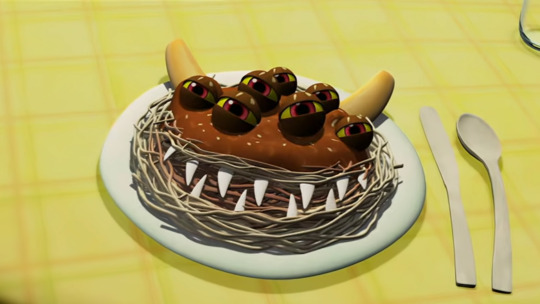
He’s hallucinating monsters in his spaghetti, kids. I don’t know what else to tell you. This boy needs therapy.
Jimmy’s gradual descent from casual trespassing and bullying in the first movie to full on vandalism and destruction in the sequel is a character arc with real stakes for more than just the humans. No longer content to simply pick on his cousin, he nearly destroys The Fright Side in his attempt to rid the world of monsters and ruin his friends’ fun. But of course all it takes is an invitation to join the party he tried to crash and a chance to meet the source of his nightmares in a less scary setting to heal his mental and emotional scarring, thereby officially welcoming him back into the friend group and ending the story on a happy note.
Step 4: Bind it all together with an “anything goes” magic system and you’re done!
As the resident witch, Scary Godmother is the primary magic user of the movies and she can do whatever the plot calls for – or whatever looks the coolest to impress the children watching. The way she uses her magic can be boiled down to a few basics: flight, teleportation, levitation, telekinesis, materialization and dematerialization, and some classic illusions.
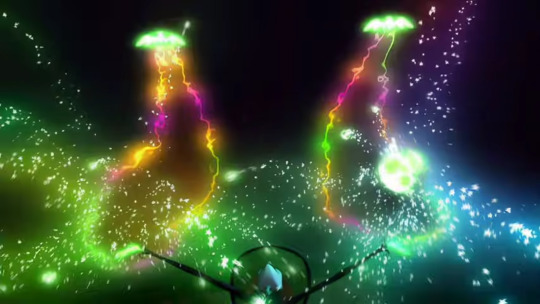
Her preferred methods of travel appear to be flying on her broomstick for long distances, teleportation for snappy appearances, and using her wings to fly around the house when walking just won’t do. She often uses telekinesis to move objects and get the house ready for Halloween or to levitate a particularly lazy werewolf out of bed.
She will materialize a spider web handkerchief to dry Hannah’s tears and one of her favorite tricks is materializing decorations on a whim for the house parties, but she summons all manner of items when needed and dispels them just as quickly once they have served their purpose. Only once or twice does she ever chant a spell while doing so, most likely for dramatic effect, so it’s safe to presume her magic doesn’t require it.
Perhaps she is at her most terrifying when she summons ethereal skeletal arms that shoot out from her hands to do her bidding against pests or when she uses her illusion magic to appear to melt her whole body into a puddle a la the Wicked Witch of the West. But most of her illusions are beautiful spectacles like releasing colorful trails of magic from her hands or hat to light up the darkness.
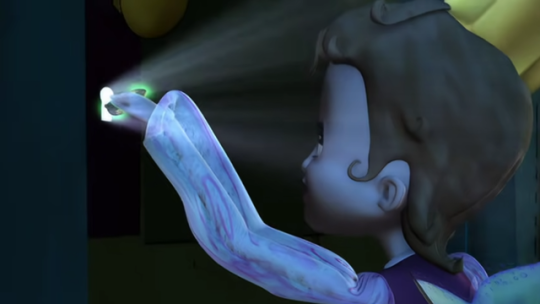
The Fright Side itself is a highly magical place with a mostly whimsical take on the concept of a magic system. According to Scary Godmother, it is responsible for such tasks as changing the color of the leaves each season, painting the clouds into the sky, and knitting spider webs. And you don’t need a magic broom to travel there either, since there is a magic key that creates a portal to The Fright Side when used on any door. But the most interesting detail is the thread that holds it all together.
You may be familiar with the concept of certain monsters or nonhuman entities that only exist if enough people believe in them. Or how about the idea that these entities’ power is determined by how many people believe in them? The Fright Side seems to work in a similar way. As seen in The Revenge of Jimmy, its magic is directly linked to how much Halloween spirit exists in the human world – particularly this one town where the main characters live, for plot reasons – because if the holiday was ever retired, not only would Scary Godmother lose her magic and the monsters become their human world counterparts… the magical world around them would disappear into the void altogether.

Final Food For Thought
So, with all that in mind, I really do have to wonder…
The magic calendar showed us that, if humans stopped celebrating Halloween or believing in it, October 31st would cease to exist at all and The Fright Side would disappear. But if the hard work of Scary Godmother and The Fright Side are responsible for such basic things as clouds in the sky and the changing seasons, how would that even work? Would what humans call science suddenly take over again to fill the gap in the universe? Or maybe what humans call science is the same thing as the magic used by The Fright Side to perform those tasks and nothing would change at all.
That’s not even addressing the fact that the complete erasure of October 31st would somehow transition the human world to a 364-day calendar. When it comes to the universe, there is usually a give and take, so would February 29th become a permanent day in the calendar to replace it and February 30th be declared a new Leap Year day to even things out?
These and many more are not questions we are meant to ask as casual viewers of the movies, but it sure is fun to think about!
Note: This article was originally posted on WordPress on October 31, 2022.
6 notes
·
View notes
Text
finally saw wicked: part 1 (2024). after literal decades in development, this actually saw the light of day, alas. but honestly…it did exceed my very low expectations. take it away, hugo montenegro.
the good:
this movie is made for the wicked theater fans. and honestly…kudos. usually movie musicals attempt to pull in as large an audience as possible by going against their source material and so end up satisfying no one. but this one is like “nope. we’re here for the theater gals and pals. we’re a musical. we just made it longer so it’s no longer the breakneck speed of the stage show. fuck everyone else” oh hell yes
for that matter, this movie is basically just act one of the movie, with a couple of extra stuff thrown in. i had hoped-feared they would include more maguire and thus mix up two complete universes in an unholy tango...but nope. there was virtually no (extra) maguire. and though it pains me to admit it…it was perhaps for the best. save all that juicy stuff for the hbo show
ariana grande as glinda. i know, i’m shocked too. i don’t give a damn about these modern pop stars, so believe me when i say that she pulled it off, even the comic bits. she’s definitely no kristen chenoweth, but you can tell she worked her ass off. that whole popular sequence came off spectacularly
jonathan bailey as fiyero. i am, indeed, a red-blooded het woman. “dancing through life” was great. also, he absolutely sold his attraction to elphaba (even if he did look better with glinda...but that was the point, so A+ casting). that said, i still miss my hot sweet ethnically ambiguous book fiyero. i would never kick bailey out of bed, but only for book fiyero did elphaba fall into a coma. just saying
elphaba/fiyero is one of the few things i give the musical a little credit for developing more, at least during the shiz years. the film not only retains it, they even give the two a classic jane eyre/rochester introduction. nice. i just wish they would have more moments together. i suspect they’re saving them for act 2
the chorus parts. they were consistently great. “no one mourns the wicked” was particularly strong.
erivo and grande’s chemistry was great and their vocal blend impressive. i was very much pleased at how good they sounded together. very nice
the wizard’s “the way to bring people together was to give them a good enemy” line was great. i just wish it would have been book wizard’s line
the bad:
“the time dragon clock” 🤮 maguire, i’m so sorry
giving elphaba an Animal nanny as if that would ~explain elphaba’s passion for Animal rights. 🤮 not this film being even more dumbed down than the musical
the slower tempos on a lot of the songs, but especially elphaba’s. also the excessive rubato. it contributed to a lot of the (albeit minor) pacing problems, imo
elphaba has always been underwritten in the musical compared to glinda, but i swear this movie took away some of her more fiery moments too. at the very least, musical elphabas had fiery and passionate lines and personality
cynthia erivo as elphaba in general. don’t get me wrong, she did cut a very grand and imposing elphaba; as the witch, she was impressive. as elphaba, though? meh. i was shocked that i didn’t like her performance as much as grande’s; i was expecting the exact opposite. as for singing, erivo is very good on the high notes, but otherwise her phrasing and delivery were off. she sounded oddly flat and inexpressive otherwise. her first line should have been sarcastic and sassy as all fuck. she was definitely a more quiet-introverted elphaba. good for vulnerable moments, i guess. i just miss book elphaba’s fire so much
the whole “wizard and i” sequence was underwhelming and cringey at parts, bogged down as it was by a too-literal presentation. we should have been seeing elphaba’s fantasies about the wizard and the crowd of ozians loving her (hell, even show the good-news-she’s-dead crowd in munchkinland for that extra dose of irony). instead, we are just watching her run across a wheat field, and then the money note and then awkward silence and then she runs back. fortunately this overall literal filmmaking was ultimately rare and seemed only to appear mostly in elphaba’s solos
having “no one mourns the wicked” in the middle of the day. i don’t know, it just feels off to my brain. it’s a pretty intense number, so i always felt it was more apropos for the nighttime. minor quibble, i guess
elphaba’s father. they changed him from a one-dimensional awful father to a cartoonish one. him meeting boq was just 🤦♀️ book frexspar, i’m sorry, they did you so dirty
the depiction of elphaba’s powers seriously gave me the ick. the opening scene especially with child!elphaba magically throwing rocks at the jeering children was...a choice. the way it was edited, it made her actions seem deliberate, with frex’s angry reaction justified. which was 🤮 for me. even later on in the movies, whenever elphaba would lose it, she didn’t seem to express much fear or even panic as she should
michelle yeoh and jeff goldblum were the weakest singers, hands down. this is fine for act 1 where they have all of (1) singing part, but goldblum is going to have to do “wonderful”which will be...definitely rough. and that’s unfortunately the best number in the musical
the ugly:
the color/lighting. no duh, but yeah. it was just so dry and desert-like. no contrast at all, and no variation, even in the emerald city. the visuals of the theater show were more stunning. what happened to crazy rich asians!jon chu?
padding, padding, everywhere. some of it was justified for the grand finale, but others was just…not. a lot of the numbers just stretched on for no good reason. for example:
the ozdust ballroom scene where elphaba begins dancing alone. it stretched on for far too long for my tastes. whereas in the musical, it was a reasonable and even touchingly significant
some of the choreography was a little off too, albeit well-danced. i don’t remember the stage choreography being this unfocused. it was perhaps saved by the good editing, but still
that “wizomania” extension + idina menzel and kristen chenoweth cameos. as much as it pleased me to see them, that part of the sequence was interminable. the new musical parts were awful melodically
the politics. the musical dumbed down so much of maguire’s oz as it was, but this movie straight up delivered some of its exposition through a fucking picture book. wtf. literally only the Animal rights plot was retained, but that one scene with all the CGI animals was the cringiest
the worldbuilding. it sucked ass, even worse than the 1939 film. i know i said the film not including anything extra from maguire’s book was perhaps for the best, but the movie’s world was so paper-thin it was see-through. maguire’s book would have been a very easy reference to solve this problem. they could have at least included the wizard-did-a-coup-and-killed-the-ozma-ruling-family element, since that at least was part of the original oz books. in the books the ozians believe dorothy is ozma returned to oz again; hence their fondness over dorothy. instead, we got wizard propaganda for 2 hours and then ten minutes of “oh, yeah, he’s a conman and a fraud btw lol we sort of forgot about that”
speaking of which, the fact that this movie whitewashed the wizard and madame morrible, even more so than the musical. in trying to keep the twist a secret, the movie just gave up on any useful foreshadowing. the authoritarian undertones could and should have been much stronger. what little of them there were completely jarred with the teen rom com vibe
“something bad.” weakest number in the musical and overall weak here. i did not care for the design for dr dillamond and the other animals. i would have preferred human actors with prosthetics, and it probably would have been cheaper
overall, this was an usually well-made movie musical. i even want to see it again, something i don’t feel for many recent movies save west side story. wicked is definitely inferior to wss in every way as a musical…but movie-wise, i really prefer chu’s directorial approach rather than spielberg’s. i think chu understands musicals and how they should be filmed better, even if the results are inconsistent. i’m glad this movie came out as well as it did, and i have high hopes for part 2. more importantly, this will open up doors to more movie musicals, so it’s a win on all fronts.
#wicked#wicked movie#wicked musical#cristina reviews#it could have been a lot of worse#overall i do approve of their choice in sticking as close to the musical as possible#they still dumbed down a lot though. did not know it was that possible considering the musical was already dumbed down#but yeah this is how movie musicals should be filmed#i am so glad it’s getting good reviews and ratings#maybe then we can have a movie adaptation of an actually worthwhile musical
1 note
·
View note
Note
I just assumed you were taking a break from talking.. Since I never do expect anyone to reply right away, or replying back as often either, so I thought you just wanted a break to do other things for yourself. And that is fine too. I never rush people into replying back every time at all either. The only reasons why I reply back right away is either so I don't forget to reply, or because I actually have energy to reply to someone. But depression is completely different because I probably won't reply, at least until after the depression is over. And being an introvert, I'm a person who is always social either. So it depends on how social I am.
~
You would think our devices would be used to how we spell the words by now. Like names. I know that I'm spelling the names right but then autocorrect keeps changing the names. Or the curse words. Dick and fuck are always changed to duck, cunt is can't, twat is that, shit is sit.. And basically so many other words get changed too. My device really should be used to my words, my cursing, and every other words too.
Spellcheck is one thing, but autocorrect is completely different for us just because spellcheck tells you the word is spelled wrong. And then autocorrect just changes the word without you realizing it lot of times as it is. That shouldn't really annoy me. But it completely annoys me.
~
Ironic how I have mixed feelings about snakes, yet I have two - maybe three - original characters with snakes as their animal motifs though.
Then I might not mind seeing pictures of animals then, it you actually wanted to send some pictures anyway. That's entirely up to you when it comes to that. I'm only just against any violent pictures of animals.
I know Japan has beetles. At least I see a lot of beetles in shows, even movies - including anime and manga - in Japanese cultures. But I am too knowledgeable about animals and insects that I can't comment.. I knew they had beetles though. But just different beetles in Australia.
The simple fact that grubs looks like maggots is skeeving me out.
~
Yes. Only High&Low characters at the moment... Watching any horror genres, I realized there are a lot of female characters who do have the witchy styled aesthetic. Amongst some people I know personally too.
And... y'know... Talking about superstitions, like black cats, even really made me think of witches. Which made me think of the witchy styles.
So that wasn't a random question. At least not for me anyway.
Rocky is definitely open minded to every type of woman, he's not one to discriminate against women. Nothing against looks, personality, or style. So I feel like Rocky might be excluded from certain questions.
I keep imagining women having a more edgy style to their look, when it comes to Cobra and Hyuga. And maybe the Amamiya brothers too. And maybe the Mugen guys now that I think about it. But.. Any styles from witchy, punk, biker and maybe even goth for some of these men might work. Unless they're into the cute preppy or tomboy type girls.
~
I have just about every season where I live. And even though we really have every season... I can see that our seasons are too bad compared to other states and even countries too. Like our winters, are never like in Alaska. Our summers can be really hot, but nowhere near humid as it is in other areas. Like with how humid the weather is in Arizona too.
So our weather can be extreme but never that extreme either... Which I am grateful for. If it's too hot or too cold, then I just stay in the house as it is. Simple as that. You've never experienced snow? You may even hate blizzards. We've had a few blizzards last year, a few feet of snow.
I never left my house. When it comes to stormy weather.. I would stay in my house, wrapped up in blankets, possibly snacks if I'm hungry in that moment while binge watching shows or movies. And sometimes my dog may join me to, if she is actually being affectionate enough to be cuddling with me. So she's only affectionate when she wants to be with other people. Oh! And candles too. It's very atmospheric for me.
So the season of autumn is different becoming cooler weathers now.
~
I don't think that I've ever tried dating sites? Or apps? Not that I could think of. I rarely ever have pictures of myself on any accounts... Either because there is rarely any decent pictures of me when I take selfies - since I'm not that good with selfie pictures, or because pictures that's been taken by someone else is always a horrible picture of me that I'd deliberately see online. I have to complain until they actually delete all pictures of me. It's not a joke. I hate when people take pictures of me.
And conversation is also another problem of mine.. I rarely start some conversations with people, I hate small talk - I prefer the conversation (about common things) over small talk. I have no interest in small talk at all. And if I have no interesting in talking, I would never reply back.
So there's that.
At least some people know you're out? So that's a start... I am no help with this. So I can't comment. At least some people know about you.
~
I have so many mixed feelings about my family, including my parents, and.. If I am being honest... I feel like most of my feelings are negative than positive. I'm a very resentful person. I admit that. Especially with my mother of all people. I have mixed feelings for her as it is. Like I do know she does everything to and for me because she cares about me in her own demented way. I know she was abused as a child so I have known that is her reason for being overly protective over me. And the reason why she rarely ever lets me leave the house on my own either, which is also another reason why I rarely bother leaving the house for myself anyway. I'm a grown woman who is still treated like a child just because of my size. I feel like she is the reason why I don't have a very normal life in the sense of having friends, dating, and anything else in this situation. If you read The Devouring Mother archetype. That's the actual definition of my mother. My mother and I are opposites in a lot of ways, in any and every way known to people who actually know us.
So my experience with my mother is kind of similar to your own too.
My mother never wants to let me leave the house, so I doubt that she would ever let me leave the country alone. And from what she did see of the movie Hostile.. She is afraid that would happen to me. Which is another reason why she's very protective of me. A smothering mother is the type of mother she is. I blame her for not having a normal life.
And besides... I think the other reason is because if I attempted going to another country. Besides money. Is that the countries I would want to visit, I might have to learn their language to communicate with any people there. And I also heard they're not always so kind to foreigners either. Depending on where you travel. And even different rules, laws, and regulations in every country as it is so I could be worried about it.
Don't forget tourist traps in some countries too.
I have been to some amusement parks in my life, not including pricey places like Disneyland. It's noisy, it's crowded. So much of everything.
Personally I think amusement parks are overrated in my opinion.
~
Okay. So I hate mentioning anything considered political.. I'm not one to mention it because the reason why I'm social media is to avoid any politics to the best of my ability. I use my exist reality, just not relive it either. But one pet peeve I have is that I follow celebrities... And this is not about their political opinions. Not at all. So if I celebrity is actually posting online (pictures that has nothing to do with politics in no way at all), then why the fuck do people political comments. And this is so the main reason why I never read comments including the other main being too many arguments and stupid commentary in the comments too. Another reason why I can not ever tolerate opinions from people.
~
Oh! You did say that before. But yeah.. You'll find out if there might be one season, depending on the finale. You'll find out in a couple weeks.
And you'll have Squid Games coming up in a few weeks.. So there is a chance you might end up seeing more of him. Unless he dies though.
Really? I liked It Follows. That was just one of the better movies I have seen in a while.. And horror movies have become so disappointing for me now. Smile was the most recent horror movie that I actually liked.
There might be more. But I can't think of any more shows and movies at the moment.. I just woke up so my mind isn't actually thinking yet.
The Terrifier was okay.. Just okay. I really feel like people overly hyped the movies. Those movies were actually more gross than scary to me.
So ew.
And exactly! Despite not every Saw movie having the best plot, they'll make an attempt to have a plot in some way or another. If they're able to. But I don't remember past the third movie since I really only watch the first three movies, I've never actually liked the movies after that.
You need to watch more anime. If you do watch more anime, I may be able to recommend some series to you. But it depends on everything.
I love Death Note, Deadman Wonderland and Kakegurui. And... Based who I am. If you ever combine the personalities and mannerisms of L, Near with the height and style of Misa. Then that's me! Even though I know it was never explicitly stated, L and Near are completely perfect examples of autism. At least for me. And! I'm not saying that because they are popular characters either (since people seem to assume that about me). But that might give you some perceptive on having one of my characters being autistic. If and when I actually write my stories.
I might have even watched one or two episodes of Shiki, but that was a lot time ago that I can't comment on that series. So no comments.
I heard of Corpse Party. I never watched the anime, and I think there's even a video game too? I never watched, played, or anything with this series. So I can't comment about this show either. So there's that too.
I know of Zom100. I've only see the trailers for both versions but I just haven't watched it yet. Maybe I will. But no promises about it though.
I don't think that I've ever heard of Happy Sugar Life, Darwin's Game, High Rise Invasion or Vampire In The Garden. No comments over any of these series either. And I would've recommended Tokyo Ghoul. But the anime doesn't live up to the manga though, they leave some plots out of the anime. So it's like this watered down version of the manga.
But I will really recommend Hellsing: Ultimate if you haven't seen it.. It is one of my favorite Dracula series. If you're interested, that's a series for you. Oh! And one of my favorite underrated series is Red Garden if you never watched it. If you do decide to watch it, I'd recommend you watching in English (since I don't know your language preferences for anime) since the series takes place in New York. Actually... I've always wanted to write a story with a similar concept of Red Garden, but just not sure for which fandom if it would be for another fandom. Anyway.
- 💋
i do a lot of writing on my ipad and even on there, autocorrect is messing with me. like, by this point, it should recognise the capitalisation of specific names that i’ve typed a hundred times. at least i’ve finally gotten in the habit of editing my fics, but there’s so many older ones with minor little autocorrect mistakes. bleugh.
~
i can see the mental line from superstitions to black cats to witches. my brain works like that too. just connecting two things that might not seem related until all the little bits are laid out.
i think a witchy style would really fit against rocky. like both of them having very, clear defined styles and aesthetics. also the obvious ‘opposite’s attract, yin yang, black and white’ thing.
i think it depends in the kind of aesthetic you’re working for the ship. like i can see cobra and hyuga being into punk-y, ‘baddass’ chic, tomboy-ish styled girls for a duo kickass couple. but i can also see them liking cuter styled girls, for the opposite’s dynamic. i think yui is a lil bit of a mix of both, she’s got a pretty mixed style but has some ‘cuter’ personality aspects, like her collection of cute stuffs.
~
it’s too hot for snow in the northern parts of australia. i think maybe tasmania gets some snow but idk. i think there’s snow in canberra?
~
i haven’t heard anything about a second season so it might just be limited series, one and done. but so long as i get my ha joon content, it’s all good. i might end up rewatching midnight actually. for halloween!
he was supposed to have died in the first season, but apparently that might not be so. he got shot in the shoulder by his brother and fell into the ocean, but his fate was left ambiguous.
i just thought it was a bit boring. i haven’t seen it in a while, but i was just kinda. bored with. i like the lead actress tho, she’s pretty. have you seen revenge, the movie from 2017?
i’d started watching death note with my brother back in the early 00s, but we’d never ended up getting very far in it. it was back when blockbusters (aa video rental shops, i do miss u) were still around.
corpse party was a game first iirc, and then the anime was based on it. i remember watching a playthrough of the game back years ago. it was like one of The games that got me into indie horror rpgs. both the game and anime are pretty gory, but entertaining. apparently there’s a couple live action movies but i havent seen those.
darwin’s game, high rise invasion, and vampire in the garden are all on netflix. darwin’s game and high rise invasion are a bit like alice in borderland, in a death games survival type way. vampire in the garden is more dark fantasy as opposed to straight horror, but it’s very visually pretty. i don’t remember who recommended happy sugar life to me, but it’s a psych horror iirc?
red garden looks interesting, i’ll put it on my list! i usually prefer watching subbed anime, just because sometimes dubs are bad. but also one of my favourite childhood animes is digimon adventures so. i can’t talk that much crap on dubs ahshdjdl i’ll send you a vid of the digimon movie dub being What It Is. it’s so funny now, but i didn’t notice how weird it was when i was a kid. it explains everything about why my sense of humour is fucked.
0 notes
Text
Interim Crit Project B (4/5/23)
My concept art project idea pretty much started from one character design which I then developed a world around.
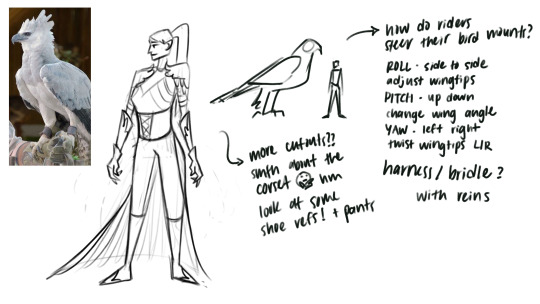
I've always loved birds, especially birds of prey like eagles, hawks, falcons, owls, etc so I wanted to design a character that was based on one. I took an image of a harpy eagle and incorporated characteristics of the bird with medieval fantasy armor. I wanted the armor to have pieces and flourishes resembling feathers, and the knight to have a cape like a feathered tail. The gauntlets are sharp to imitate the talons of an eagle and the overall silhouette is pointed. I kept shape language in mind and wanted the character to have a triangle shape to emphasize her dangerous nature as a warrior.
I think I ended up choosing a fantasy inspired genre because I've been reading a lot of fantasy books in the past few months. I used to be a really avid reader through elementary and middle school, and my favorite genre back then was anything to do with dragons and talking animals. One of my favorite franchises ever is How to Train Your Dragon, both the book series and movie trilogy. I fell off reading books when I started high school because the internet was much more accessible by then, but for 2023 I decided to get back into it!
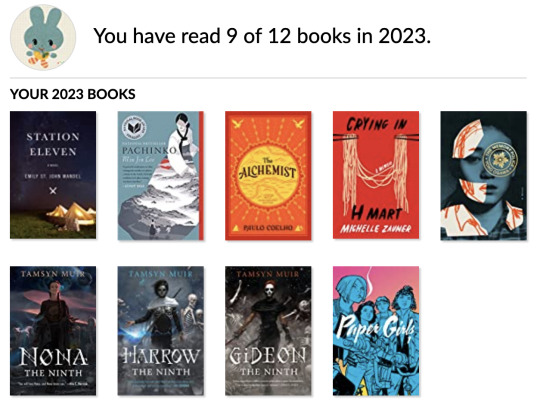
So far my 2023 Goodreads challenge has had a pretty considerable ratio of fantasy books, specifically the Locked Tomb series starting from Gideon the Ninth. The Locked Tomb is a bit of a mix of fantasy and sci-fi, but knight cavaliers and necromancer sorcerers are pretty central to the story, which definitely led to the knight decision.
From the character design, I started thinking about what kind of world this knight could inhabit and why would her armor be so heavily inspired by birds. The two main influences that I combined to create the world this character design by Airi Pan and the Great Eagles from Lord of the Rings.
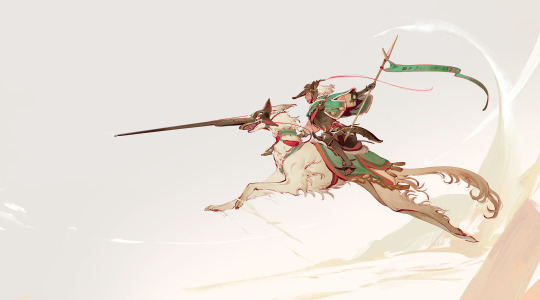
I love the idea of taking any animal and having it become a knight's trusty mount, and the Great Eagles already set precedent for large birds that can be ridden, so I decided to create a world based on the concept of eagle knights.

I started gathering references for the influences that I want to go into the world, from fantasy medieval knights to birds of prey, to treehouses and bird nests. I took notes on areas that could be fleshed out for worldbuilding purposes, thinking about different classes of knights and their different bird mounts.
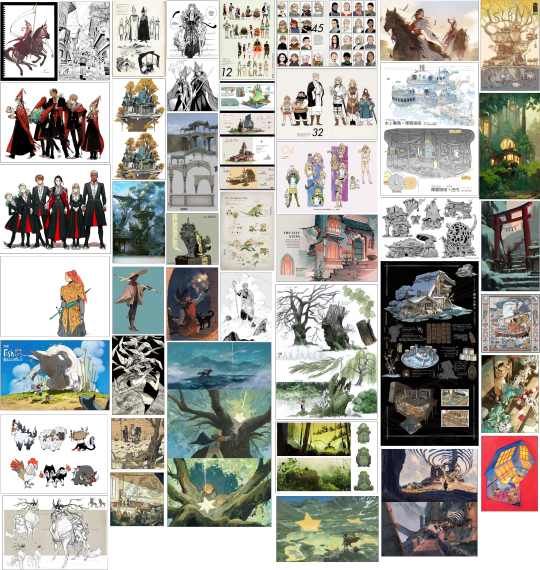
Next, I also created a reference board of visual development art. I wanted to have a lot of different types of concept art to reference and prompt me to think of different aspects of worldbuilding. Two manga titles that really inspire me are Witch Hat Atelier by Kamome Shirahama and Dungeon Meshi by Ryoko Kui. Both are manga series written and illustrated by women, and are set in incredibly lush fantasy worlds.
I was inspired to start reading Witch Hat Atelier after hearing that it has great representation of disability and darker skinned characters, which is really rare for both the fantasy genre and Japanese manga. The character designs in Witch Hat Atelier are gorgeous and fantastically diverse, yet cohesive in a way that I really appreciate.
youtube
I picked up Dungeon Meshi after watching this amazing breakdown video on character design in the series. Ryoko includes extras in some of the volumes which demonstrate her great attention to detail in character design. Her character portrait lineups show diversity in their facial features and physical makeup, and she also makes sure that even when her characters have swapped costumes, they're still distinguishable from each other. There's a large range in body shape and size in the cast, even for women, whom Ryoko isn't afraid to design outside of the typical beauty ideals.
Besides character art though, I also have environment designs and creature designs in my reference board. I think it's important to have sheets that describe the detail of specific environmental details in a technical way, but also more rendered paintings that establish the mood and atmosphere of a world.
0 notes
Text


Samantha Archembeau is an optimist, a ray of sunshine if you will. She comes from a family of witches from Paris, her parents have always told her stories from their time as students at Phantasma High, she would read stories about witches and other supernaturals and spent time in her aunt’s Magic Supplies shop, where her aunt would teach her a lot of things about witchcraft. It was when Samantha saw a parade made by illusionist witches led by the famous member of the magic council, Michelle Wonder, who became her idol.This inspired her to become a master in illusions, as illusion spells could give the world more colour, and required a lot of artistic knowledge to master.
However, being a student at Phantasma High was less than stellar, as magic is slowly is slowly losing its purpose in society, and a lot of people become witches out of obligation rather because that’s what they truly enjoy.Samantha won’t lets this get her down and tries to see the full part of the glass.Now that she is in Senior Year, she is trying to make the best of the time she has left in highschool, enjoy every second and have fun.But deep down she dreamed that things would be more exciting, that she would have a grand adventure…
And her wish came true, well, somewhat. She is the superhero Sunrise, and she is trying to solve the mystery of the strange event that happened at the school library during midnight. This leads her down a rabbit hole and discovers the world like she has never seen it before, full of mysteries, villains and secret agents.
Samantha is a huge fan of cartoons and magical girl and shonen anime. She enjoys cosplaying and drawing, her art style is colorful and dynamic, a mix between the movies and shows that inspire her.She also is a roller skater. She, more than anything likes meeting new people, making friends, even though she wouldn't admit it, Samantha is afraid that she annoys people, that she is a burden and deep down just wants to be reassured that everything is OK, that her presence is not annoying.And that's where Gail comes in, as with his kind eyes and unbridled patience, Samantha feels safe and comfortable around him.
Gail Williams is socially awkward and deeply insecure, there is no other way to put it.He is a student at Roundtable Academy, so you know the drill, he pressure the school puts on the students and its competitive nature have turned Gail into a people pleaser, a pessimistic soul who doesn't see purpose in dreaming of something better, but still wants to see those he cares for happy.
He moved with his romanian mother in London, after his father’s death, to go to the same school he studied to, but also because his mother wanted a scenery change, a fresh start after that tragedy.He met Samantha in freshman year, in a very awkward way, they briefly knew each other, from the many times Roundtable Academy and Phantasma High would do collaborative events.But the moment their friendship truly started to form was when the two of them started going to the anime club taking place at the “Books’ World”, since then the two of them have been inseparable.
Now Gail is a senior in highschool, regretting how stale things have been in his life, wondering if the promise of the great high school experience was ever true.He is stressed about college, about graduating, about what comes next.All of these things are frustrating him, but he doesn’t show it. Gail enjoys drawing, creating characters, thinking about their world and their stories, reading comic books and playing the guitar.Gail is reserved and finds it difficult to open up to people, but he is surprisingly talkative with the friends he already has, especially Samantha.He is soft spoken and always tries to help out his friends, even if he himself needs help…
#digital art#oc art#artists on tumblr#oc artwork#Knights and Watchers#oc drawing#oc story#digital drawing#drawings#fantasy oc#witch oc#trans character#character illustration#illustration#Gail Williams#Samantha Archambeau
0 notes
Text
Witch Hazel's Pumpkin Pie
(Disney Recipes: From Animation to Inspiration)


Left Page
"In the short movie Trick or Treat (1952), lovable wacky Witch Hazel joins up with Huey, Dewey, and Louie to play a few tricks on their crotchety uncle Donald. She uses her knowledge of magic to conjure up a potion able to bring pumpkin masks terrifyingly to life and turns solid fence posts into ghosts. If you ask us, she should have used her spells in the kitchen to prepare special treats for Halloween. Try working a little of your own magic with this zippy version of a classic autumnal dessert: all you need is an open mind and willingness to try something new. Be daring and see whether your guests reward you with a trick or treat."
"Trick or treat for Halloween, better give a treat that's good to eat, if you gonna keep life serene! Kids! The stuff's looooaded!"
Right Page
HOW TO MAKE IT
8 Servings 2 Hours Preparation Time
INGREDIENTS
PIECRUST
8 ounces - flour 1/4 teaspoon - salt 1 teaspoon - New Mexico chili powder 4 tablespoons - butter 3 tablespoons - ice water
FILLING
4 ounces - cream cheese, room temperature 3 tablespoons - finely chopped candied gingerroot 15 ounces - candied pumpkin puree 14 ounces - canned condensed sweetened milk 2 - eggs, separated 1/4 teaspoon - ground cinnamon 1/4 teaspoon - ground nutmeg 1/4 teaspoon - ground cloves 1/4 teaspoon - salt
TOPPING
2 tablespoons - flour 2 ounces - brown sugar 1/2 tablespoon - finely ground black pepper 2 tablespoons - butter 4 ounces - hazelnuts, coarsely chopped
PIECRUST
Place flour, salt, and chili powder in the bowl of a food processor. Pulse once or twice to combine. Add butter, pulsing on and off until mixture resembles small peas.
Sprinkle in cold water and pulse 3-4 times until mixture forms a ball. Remove and refrigerate for about 15 minutes.
When chilled, roll out to 1/4-inch thickness, about 10 inches in diameter. Roll onto rolling pin, then fit into pie pan, and uniformly finish edges. Refrigerate until needed. This may be done a day or two in advance.
FILLING
Preheat oven to 425 degrees (Fahrenheit). Prick bottom of shell with a fork to prevent it from rising during baking.
Blind bake shell for 10 to 12 minutes, or until lightly browned; then allow to cool. In a small bowl, combine cream cheese with candied ginger, then spread on prebaked piecrust, being careful not to break crust.
In a large bowl, mix pumpkin, sweetened condensed milk, and egg yolks. Stir in cinnamon, nutmeg, cloves, and salt.
In a separate large bowl, whip egg whites until soft peaks are formed. Fold into pumpkin mixture and pour filling into piecrust. Bake for 15 minutes in preheated oven.
TOPPING
While pie is baking, prepare topping. In a small bowl, combine flour, brown sugar, and black pepper. Blend in cold butter with a fork until mixture is crumbly. Mix in chopped hazelnuts. Sprinkle topping over pie after baking for 15 minutes. Reduce heat to 350 degrees; bake for an additional 40 minutes, or until set.
VARIATIONS
Other nuts may be used in the topping, or, if you prefer, removed completely. Substitute black pepper in the crust with ground cardamom for a sweeter, milder topping.
MENU IDEAS
Try a bowl of "Cookie's Special Chili" and come cold "Heroes' Herculade" to drink before a slice of this pie.
WHAT CHILDREN CAN DO
Little hands can combine cream cheese with candied ginger, and mix ingredients for the topping.
Disney Recipe Poll Round 5
Previous Poll
Recipe List
7 notes
·
View notes
Text
☆ちゆちゆブログ☆《ちゆたん》
2018-01-26
Konnichiyu ฅ۶•ﻌ•♡ I turned 20! I’m an adult Chi~yu~ \( ˆoˆ )/ ❤︎Chiyu Birthday❤︎~I’m not a kid anymore!~ A lot of people came to see me! Thank you so much!!!

I packed in a lot of things I wanted to do and the hour and a half went by in the blink of an eye!
① First, a lyrics change to “kissy-men” Chiyu-tan♪Chiyu-tan♪Kyou wa Chiyu-tan♪ [”Chiyu birthday, Chiyu birthday, today is Chiyu birthday”] It was fun~(*´▽`*)

② Tenkasu Trio’s “Eien no Trinity” I had planned on doing it from the start, but then I heard about Momoka’s graduation* and I wanted to sing it to the best of my ability. I really love this song, and Tenkasu Trio is eternal!! I had a text exchange with Hinata saying we should sing it together, too!♪

③ ANGERME (S/mileage) Medley♪ “Yume Miru 15 (20)” “Uchouten LOVE” “○○Ganbaranakutemo Ee Nen De!!” “Sukichan" “aMa no jaku” My sister said my choices are divine, so I was happy! lol

④ YUI ”Happy Birthday to you you” →Chiyu acoustic guitar x Conan acoustic guitar YUI songs were the reason Chiyu started playing guitar ♡ I was also happy that everyone could sing along!

⑤ Team Syachihoko’s “Lace no Curtain wo Yurashita” →Chiyu acoustic guitar x Conan keyboard This was a song I picked as a challenge! I wonder how I did?

⑥ SEKAI NO OWARI “RAIN” →Conan keyboard The keyboard section is intense, so it felt good to sing to it~! I love SekaOwa songs so much! It made me remember “Mary and the Witch’s Delivery Service”~♪ Everyone should watch it❤︎

⑦ Takahashi Yuu “Ashita wa Kitto Ii Hi ni Naru” →Chiyu acoustic guitar x Conan acoustic guitar I picked this song so that everyone would feel happiness every day, including tomorrow! Thanks for keeping the beat for me♡

⑧ Team Syachihoko “Jirijiri Natsu Katsu Iinkai” I like this song! It’s fun♪
⑨ Team Syachihoko “Dera Disco” Ii ne ii ne♪ Chiyuri!***←I laughed~(〃ノωノ)♡

Thank you for the encore call, too! I was also happy to receive a video message from Honoka and Nao, and then to my surprise Yuzuki and Haru came on stage♪ I was super happy~\( ˆoˆ )/ Thanks for the cute cake♡

Also, ⑩ Chiyu’s solo song “Naite nanka Inai yo” Chiyu acoustic guitar x Conan keyboard


Conan played for me quite a bit, thank you so much! Please collaborate with me again♪ I also got to sing a song that I wrote at the end! I forgot to switch the guitar I was playing so I ended up a bit wobbly at first, but everyone listened the who~le way through and that made me happy!!! My handwriting is super messy, but I’ll post this for you! lolol

So this is how I started my 20th year! I can still see many challenges ahead of me, but I want to clear each one and challenge different things and become a super adult Chi~yu~! To those who couldn’t come to the show thank you for your celebratory messages! The people who put up posters around town, the different shops who put them up, I felt so much love from all of you ♡ For people to be this kind to me, to put their all into a unifying force, to always be supporting me, you’ll always be close to my heart ♡ Meeting all of you, the fans, has been my greatest treasure! Please keep taking care of me♪


I’ll be posting the pictures of the flowers you sent me on Insta \( ˆoˆ )/ Take a screenshot♪ ☆Chi~yu☆
#Tenkasu Trio is a sub-unit of Stardust featuring Chiyuri#The other members are Kashiwagi Hinata of Ebichu and#Ariyasu Momoka of Momoiro Clover Z who just had a sudden graduation from the entertainment industry as a whole#**This isn't a real movie#She mixed up two anime movies about witches#The song she performed is from Mary and the Witch's Flower#Kiki is the one with the delivery service#In the song each member says ii ne ii ne and then their name so doing it solo she said her name 5-6 times in a row#Chiyuri Itou#Itou Chiyuri#伊藤千由李#チームしゃちほこ#team syachihoko#teamsyachihoko#blog#translation#Japanese#japan#idol#female idol#femaleidol#j-idol#j idol#jpop#Stardust#Stardust Planet#Stardust Promotions#3BJr
3 notes
·
View notes
Text
If you’re for feeling tempted to watch the Supernatural prequel because of the new diverse character announcements, I’m here to remind you that there are other fantasy/sci-fi/horror TV shows that not only have diversity (but are even led with it!)
“I want to watch a monster-hunting show led by a powerful woman!”
Wynonna Earp (SyFy): two sisters, one a wise-cracking but badass hunter of the undead and the other a more serious but sweeter girl with mysterious monster origins, are reunited after years apart. Basically, it’s Supernatural but funnier (and gayer!)
Van Helsing (SyFy): a re-imagining of the vampire hunting icon that follows his descendant Vanessa Helsing,
Warrior Nun (Netflix): A girl comes back from the dead and learns she’s part of a secret order of demon-hunting nuns.
Lost Girl (SyFy): Bisexual succubus Bo and her human best friend Kenzi become private investigators of the world of the “fae”, supernatural beings that range from fairies to wolves to sirens and succubi like Bo.
“I want to watch a show about Asian characters in the world of fantasy and monsters!”
Okay well, first off, I also cannot begin to tell you about how many amazing non-American supernatural shows are out there if you’re willing to read subtitles. A couple of my personal favorites are Black (a Korean horror/fantasy/mystery show about reapers and a woman who can see when people will die, Netflix) and All of Us Are Dead (a new action-fantasy drama about high schoolers battling a zombie invasion, Netflix) and I would love to hear people rec their faves, too! A few that don’t need subtitles though…
Shadow & Bone (Netflix): A well-received adaptation of the high fantasy book series, with a diverse writing staff and cast including half-Chinese Jessie Mei Lei as the lead. Fan-favorite characters from the sequels such as Inej and Jesper (a South Asian woman and a mixed-race bisexual man respectively) also got integrated into the series early and become prevalent characters in the books’ spinoffs.
Marvel’s Runaways (Hulu): a darker, teen superhero show with the found family themes you always wanted from their movies. Its highlight is easily Nico Minoru, a Japanese-American and queer sorceress who learns her and her friends' parents are part of a super-villain organization
Wu Assassins (Netflix): a Chinese-Indonesian man in San Francisco discovers he has magical origins and has to fight to keep his family’s power out of the wrong hands
Teen Wolf (MTV/Amazon Prime): While only part of the cast for Season 3-5, the show’s introduction of Japanese-Korean Kitsune Kira Yukimara and her mysterious family led to the shows’ most well-received storyline and arc. She teams up with troubled teen werewolf Scott McCall and his pack to fight an evil creature tormenting the town.
And of course Avatar: The Last Airbender and its sequel Legend of Korra (Nickelodeon/Amazin Prime): AMAZING animated shows with all-Asian characters and original fantasy world inspired by multiple East Asian and South Asian countries. They may be kids’ shows but they deal with a lot of heavy and mature themes that make it enjoyable for any age.
“I want to watch a genre show with a Latino lead (bonus points if queer!)”
What We Do in the Shadows (FX/Hulu): a horror-comedy TV spinoff of Taika Waiti’s iconic and hilarious vampire mockumentary film, with racially diverse writers and cast and basically all LGBT lead characters. The true heart of the show is the queer, Mesztizo and Mexican human character Guillermo (whose identity isn’t hypersexualized like some of the vampires characters’ more fluid bisexuality/pansexuality are)
The Owl House (Disney): yes, another animated kids’ show, but I cannot recommend this fantasy series enough especially to any former "Harry Potter" fans. It’s led by a teenage, Latina human who discovers witches and a secret world of magic and is eager to learn so she can be a part of it. Luz is also bisexual, and her relationship with another young witch has been one of the most talked about storylines of the show.
Penny Dreadful: City of Angels (Showtime): a horror-drama spinoff of Penny Dreadful set in Los Angeles in the 1930s that tackles both Mexican-American tensions and folklore with characters connected in a conflict between the angel Santa Muerte and demoness Magda.
Roswell, New Mexico (The CW/Netflix): While I’m hesitant to recommend any CW show, this remake of the 90’s sci-fi drama/romance (which infamously whitewashed characters from the books) ingrains diversity into the cast and plot, with the Mexican-American lead’s immigrant family dealing with real-life racial tension in New Mexico in addition to the show’s original storyline of immigrant aliens adjusting from life on a whole other planet.
p.s. adding to this list is not only okay but highly encouraged!
#just a note I have not watched every show here yet but have a few on my to watch list that I'm excited about#also not every show here is free from problematic representation#like despite its cuteness wynonna earp's main wlw romance involves a cop y'know#but I think they're all steps in the right direction and that's what matters#long post#spn prequel#supernatural prequel#supernatural spinoff#ntjdmakesthings
251 notes
·
View notes
Note
Do you think politics should be kept out of fictional stories, or just from satires like The Addams Family?
Before I get to The Addams Family mixing with politics or not, let me clarify one thing: there's a difference between an artist adding political commentary to their work, and a big corporation like Netflix doing things like adding random political slogans to a character's dialogue to sell their product as "woke."
To make my point clearer, let me compare two properties BY Netflix.
First we have the anime Cyberpunk Edgerunners. It is a dystopia in which the people in charge have so much power, they can get away with OPENLY treating human life as absolutely disposable in every way because all that matters is that they keep making money, and the characters are just trying to make a living, their own way, so the system won't crush them like bugs.
The politics is part of the world building, and it is presented through us as just another part of the narrative - the challenges the characters face, and the consequences of them getting their way, or failing miserably.
Meanwhile, there were the random “woke” moments in Wednesday. A guy saves her life in the first episode. This leads to her being rude to him and asking if he saved her because women are all fragile damsels in distress that need a man to help them.
Wednesday had no idea who this guy was. She had no reason to believe he was sexist. He did not condescend to her in any. All did was help her out, and then explain to her what happened when she woke up at the infirmary.
Now, about your actual question: politics are, unfortunatelly, a part of life, so naturally that is reflected in fiction, and to pretend that political messages haven’t been a part of a ton of great shows, movies, and books is not just silly, is downright stupid. However, like anything in the writting process, it has to be done right - and what is right for one story, is completely wrong for another.
This wasn’t a “strong female character telling the patriarchy to fuck off”, it was a character spewing out cheap “empowering” lines to make the internet call her a feminist icon - and thus keep their Netflix account, praise the show, and recommend it to others for having said “feminist icon.” It is the equivalent of writing a scene with Wednesday’s roomate telling her - or rather, the audience - that she loves Netflix because it has all the best shows and movies she could ever want to watch.
This is as "bold" as Disney announcing it's 50th first gay character, which will get three seconds of screentime. It's not the writers sending a message to the audience, it's fake activism in it's laziest form.
Avatar The Last Airbender and A Song Of Ice And Fire are both stories that have among their themes grief, trauma, and the horros of war. Both could have key characters meeting a duel, but only Avatar could get away with making said duel a parody of a wresteling match, including an obvious stand in for The Rock, because it was a kid’s how and comedy was a big part of it. Both could have characters getting hurt or even dying, but only ASOIAF could show/describe these scenes, because it is aimed at adults and has a much darker, and straight up brutal tone.
The Addams Family is satire. That genre is PERFECT for the best kind of political commentary: the kind that is made through witty and/or silly jokes.
However, for said jokes to feel natural in the story, they have to be true to the essence of the characters - and the Addams’s main trait is that they’re weird, sometimes scary people.
To give you an exemple, in the first movie, we have a scene of Morticia proudly telling her daughter’s teacher that one of their relatives danced naked in the town’s square, enslaved a minister, and was burned as a witch. Morticia then says that she told her daughter that she is not only allowed to do the same, but is actually encouraged to, but only after she goes to college to get a proper education. This shows the Addams have exactly zero problem with women that were demonized through history because they were sinful, lustful, evil witches, and all that great stuff.
However, the same movie also mentions how they did the Mamuska, a traditional dance of their family, in honor of Jack The Ripper - a serial killer who violently murdered sex-workers.
This could look like a contradiction, but it isn’t, because the Addams’s whole deal is celebrating EVERYTHING that regular people find creepy, distasteful, sinful, inappropriate, morbid, vile, scary, etc.
Another exemple would in the sequel, Addams Family Vallues, in which Gomez and Morticia are listing all the “baby names” they thought of before finding the correct one - and among the options were both Lucifer and Mao.
Now, obviously this is the writers pointing out that Mao, the dictator that ruled China with an iron fist for years, was such a horrible person, he could be compared to the actual devil. But it also means that the Addams are not only okay with the guy, they actually considered naming their son after him. The movie is bashing Mao, but Gomez and Morticia are praising him for his terrible actions as a dictator - while the fact that he was a communist dictator is irrelevant, because the Addams are not communists. The joke is political, the characters are not.
And the super racist thanksgiving play Wednesday ruins in that same movie? She only did that because she was forced to participate in it, and she was sick of their fake, imposed happiness, that went as far as pretending that a massacre was actually a friendly dinner between the “civilized” europens and the “savage” natives. The scene was political, but the character was just doing something she knew would horrify and anger her enemies.
Even in THE tamest version of the Addams Family, the TV series of the 60s that had to drop nearly all of the dark humor, that element wasn’t lost.
There is an episode in which Gomez is supporting a politician. When Morticia asks him why in the world would he vote for a guy who is promising to destroy all the swamps when the Addams all like swamps, Gomez says that this is exactly why he is voting for him: is a campain promise, and everyone knows those are exactly what the guy will NOT do if he is elected.
But Gomez is still super friendly to the guy (the Addams way, which creeps him out), and there is no tension about how the other candidates are horrible and thus this guy is the good one, or at least the lesser of the evils they get to chose from. It is not taken seriously AT ALL. It’s just another excuse to have the Addams freaking the normies out.
The show was also praised for being one of the few family series that had the parents being actually happy together and in love, and taking good care of their kids. This was 100% because of the satire element, showing that the people who didn’t conform to what the traditional american family should be like were one of the few american families that were actually happy - but the Addams never point that out to us. Because it isn’t an act of rebellion on their part, at least not intentionally, they’re just living their lives.
They are NOT like us, so our ideas of politics could NEVER apply to them, because they simply can’t relate to it. That doesn’t mean the writers can’t add political commentary to the story - it just means they have to actually be competent at ballancing “these are my beliefs” and “this is what feels natural for the characters to do”
14 notes
·
View notes
Text
The Sea Beast review
I watched the movie last night so I thought I’d give a mini review
For the most part, I actually like it a lot.
The creature designs were fun and it’s rare to see entirely aquatic kaiju. I do wish the main “monster” Red had a little more texture to her like maybe tubercles on her fins like a humpback, because she kinda looks like a sea lion version of toothless.
Also my inner phylogenetisist flared up and so a lot of the monsters are hard to classify for me… but also in one of the scenes I think a character sells their soul to a witch so there’s probably magic at play.
As for the story… it’s a little mixed
It’s a story about ending cycles of violence, how history is written by the winners, and how people in power will lie to keep their power. I do think it succeeds in telling this message to kids, and there were some moments I thought were pretty good, but it falls a little short under the scrutiny of an adult.
I think some characters change sides too easily and also I think a mob of people in a royal kingdom might need a little more convincing than being told “hey this war against sea monsters is just pointless bloodshed that was started by royalty, and then the royals lied about it for generations to keep it that way while they lived all cushy”. Like, maybe point out some of the lies in the books. Then again the speech was delivered by a child standing on the biggest baddest sea monster known (which everyone has been told for generations just mindlessly goes out of its way to kill people), which she also befriended and told to not hurt anyone, so maybe that’s what convinced everyone.
Ultimately I think it’s a good enough movie and I’m glad more pieces of media are tackling these topics nowadays, but it’s not anything exceptional in the story department.
If you want a good kids movie about how history is written by the winners, watch Trolls Wold Tour
If you want a good kids movie about how violence breeds violence, watch HTTYD
If you want a kid to learn about how those in power lie to stay in power, just tell them about the people in parliament or the White House
Other thoughts:
Visuals are amazing as expected for a big budget animated movie nowadays, although I was stunned by the water animations. Water is a nightmare to animate and I don’t think there was a single shot where it looked a little off.
There’s two curse words in the movie, ass and hell, a nice tasty vocabulary snack for the kiddles, would recommend
27 notes
·
View notes